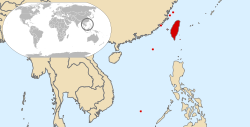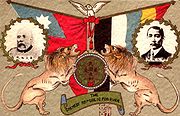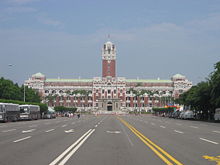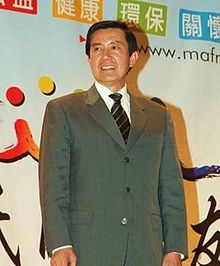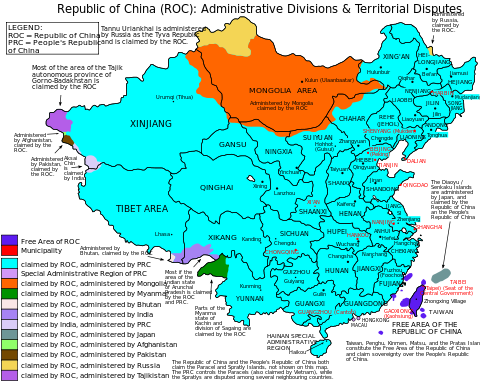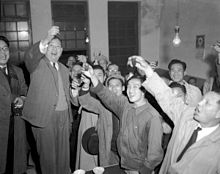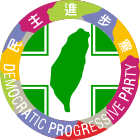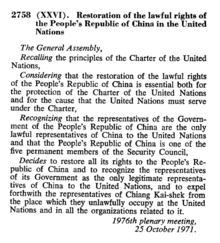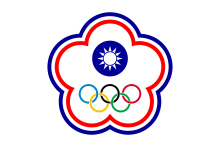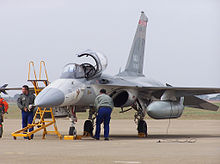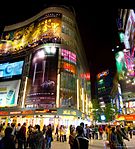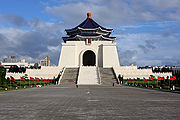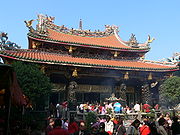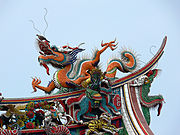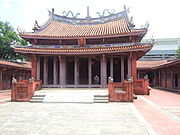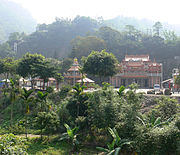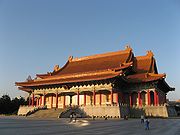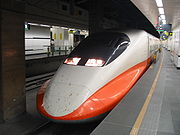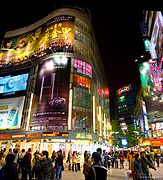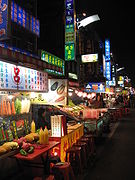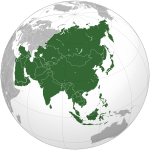- Republic of China
-
This article is about the sovereign state on Taiwan since 1949. For the territories currently governed by the Republic of China, see Taiwan and List of islands of the Republic of China.Not to be confused with the People's Republic of China.
Republic of China 

Flag Emblem Anthem:
“National Anthem of the Republic of China”
《中華民國國歌》
“National Flag Anthem”
《中華民國國旗歌》depicting the Free Area of the Republic of ChinaCapital Taipei[1][b]
25°02′N 121°38′E / 25.033°N 121.633°ELargest city New Taipei Official language(s) Mandarin[2] Recognised regional languages Taiwanese Hokkien
Hakka Chinese
Formosan languages[3]Official scripts Traditional Chinese Ethnic groups 98% Han[4][5]
70% Hoklo
2% Taiwanese aborigines[7]
14% Hakka
14% Mainlanders[6]Demonym Taiwanese[8][9][10] or Chinese[11] or both Government Presidential republic - President Ma Ying-jeou - Vice President Vincent Siew - Premier Wu Den-yih - President of the Legislative Yuan Wang Jin-pyng Establishment Hsin-hai Revolution - Wuchang Uprising 10 October 1911 - Republic established 1 January 1912 - End of Japanese rule in Taiwan 25 October 1945 - Constitution 25 December 1947 - Government relocated to Taipei 7 December 1949 - Withdrawal from the UN 25 October 1971 - First direct presidential election 23 March 1996 Area - Total 36,191.4667 km2 (136th)
13,973.6 sq mi- Water (%) 10.34 Population - 2011 estimate 23,174,528[12][c] (49th) - Density 640/km2 (16th)
1,658/sq miGDP (PPP) 2010 estimate - Total $824,671 billion[13] (19th) - Per capita $35,604[13] (20th) GDP (nominal) 2010 estimate - Total $418.206 billion[13] (24th) - Per capita $18,558[13] (37th) Gini (2008) 34.1 [14] (medium) HDI (2010)  0.868*[15][16] (Very high)
0.868*[15][16] (Very high) Currency New Taiwan dollar (NT$) ( TWD)Time zone CST (UTC+8) - Summer (DST) not observed (UTC+8) Date formats yyyy-mm-dd
yyyy年m月d日
(CE; CE+2697) or 民國yy年m月d日Drives on the right ISO 3166 code TW Internet TLD .tw, .台灣,[17] .台湾 Calling code +886 a. ^ See also Names of China. b. ^ Nanking (now Nanjing) was the seat of the government from 1928 until 1949 except during wars, when the government retreated to Taipei.
c. ^ Population and density ranks based on 2008 figures.Republic of China Traditional Chinese 中華民國 Simplified Chinese 中华民国 Transcriptions Gan - Romanization tung1 fa4 min4 koet7 Hakka - Romanization dung24 fa11 min11 gued2 Mandarin - Hanyu Pinyin Zhōnghuá Mín'guó - Wade–Giles Chung-hua Min-kuo - Bopomofo ㄓㄨㄥ ㄏㄨㄚˊ ㄇㄧㄣˊ ㄍㄨㄛˊ Min - Hokkien POJ Tiong-hôa Bîn-kok - Min-dong BUC Dṳ̆ng-huà Mìng-guók Wu - Romanization tson平 gho平 min平 koh入 Cantonese (Yue) - Jyutping zung1 waa4 man4 gwok3 The Republic of China (ROC), commonly known as Taiwan (see below), is a unitary sovereign state located in East Asia.[18] Originally based in mainland China, the Republic of China currently governs the island of Taiwan (Formosa), which forms over 99% of its current territory,[19] as well as Penghu, Kinmen, Matsu and other minor islands. Neighboring states include the People's Republic of China (PRC) to the west, Japan to the east and northeast, and the Philippines to the south. Its capital city is Taipei.[1]
The Republic of China, established in mainland China in 1912, governed most of mainland China (without Taiwan, which was under Japanese rule), then received Taiwan and accompanying islands from the Empire of Japan under terms of surrender at the end of World War II in late 1945, when both mainland China and Taiwan came under the ROC rule for four years until 1949.
The ROC lost its mainland territory to the Chinese Communist Party who founded People's Republic of China (PRC) on that territory after major battles ended in the Chinese Civil War in 1949, and relocated its government to the island of Taiwan, which composes most of its current territory. Therefore the country is also commonly called "Taiwan".
The state now commonly known as "China", the People's Republic of China (PRC) and ROC both claim to represent all of "China" (in a definition including Taiwan), and both officially claim each other's territory. The PRC actively pursues this claim, whereas although the ROC also officially has this claim under its constitution, in practice, the ROC government has ceased to actively pursue this stance since 1992.[20] Due to the PRC's insistance on this claim, and the fact that no peace treaty has ever been signed between the two countries to formally end the Chinese Civil War, the PRC claims to reserve the "right" to attack the ROC/Taiwan any time, particularly if the ROC declares formal independence as Republic of Taiwan. This ongoing dispute over the claim to be the legitimate government of "China" and who has sovereignty over Taiwan is a lingering issue from the unresolved civil war and forms part of the complex political status of Taiwan.
The tension between the two Chinas colors most of the political life in Taiwan, and any move towards "Taiwan independence" is met by threat of military attack from the PRC.[21] The PRC's official policy is to reunify Taiwan and mainland China under the formula of "one country, two systems" and refuses to renounce the use of military force, especially should Taiwan seek a declaration of independence.[22]
The political environment in Taiwan is generally divided into two major camps in terms of views on how Taiwan/Republic of China should relate to PRC/Mainland China, referred to as Cross-Strait relations. It is the main political difference between two camps: the Pan-Blue Coalition (majority Kuomintang) believes that the ROC is the sole legitimate government of "China" (including Taiwan) and supports eventual Chinese reunification under the terms of 1992 Consensus, which defines the One China Principle. The opposition Pan-Green Coalition (majority Democratic Progressive Party) regards Taiwan as an already independent, sovereign state synonymous with the ROC, opposes the definition that Taiwan is part of "China", and seeks wide diplomatic recognition and an eventual declaration of formal Taiwan independence.
The issue over whether to maintain the status quo, reunify with mainland China, or declare formal independence divides the ROC's populace and is a sensitive subject that many avoid discussing, even though it affects their future. It is also is a key reason for Taiwan's identity crisis of whether to identify themselves as "Chinese" or "Taiwanese".
The Republic of China is a multi-party democracy that has a presidential system and universal suffrage. During the latter half of the twentieth century, the Republic of China on Taiwan experienced rapid economic growth, industrialization, and democratization. Despite of its controversial political status, the ROC is an industrialized advanced economy. It is one of the Four Asian Tigers and a member of the WTO and APEC. The 19th-largest economy in the world,[23][24] its advanced technology industry plays a key role in the global economy. The ROC is ranked highly in terms of freedom of the press, health care,[25] public education, economic freedom, and human development.[15][16][26]
Contents
Names
See also: Names of China#Republic of China and Chinese TaipeiThe official name of the state is "Republic of China"; it has also been known under various names throughout its existence. Shortly after the ROC's establishment in 1912, while it was still located on the Asian mainland, the government used the abbreviation "China" ("Zhongguó") to refer to itself, for instance during the Olympic Games[27] or at the United Nations. During the 1950s and 1960s, it was common to refer to it as "Nationalist China" to differentiate it from "Communist China" (or "Red China").[28] The ROC also called itself "Free China" in an attempt to portray the PRC as an illegitimate government. At the UN, it was present under the name "China" until it lost its seat to the People's Republic of China in 1971. Since then, the name "China" has been commonly used internationally to refer only to the People's Republic of China, except in countries that diplomatically recognize Republic of China and thus refer to the ROC as "China".[29] Over subsequent decades, the Republic of China has become commonly known as "Taiwan", due to the fact that Taiwan, the island, composes most of its territory. It is also often informally referred to as the "State of Taiwan", in particular in countries where the ROC is not officially recognized.[30][31][32][33] The Republic of China participates in most international forums and organizations under the name "Chinese Taipei" due to diplomatic pressure from the PRC. For instance, it is the name under which it has competed at the Olympic Games since 1979, and its name as an observer at the World Health Organization. Additionally, the PRC refers to Taiwan as "Taiwan, China" in pursuit of its claim that it is under the sovereignty of the PRC.
History
Main articles: History of the Republic of China and Republic of China (1912–1949)The Republic of China was formally established on 1 January 1912 on mainland China following the Xinhai Revolution which itself began with the Wuchang Uprising on 10 October 1911, and replaced the Qing Dynasty and ended over two thousand years of imperial rule in China. It is the oldest surviving republic in East Asia. The Republic of China on mainland China went through periods of warlordism, Japanese invasion, and civil war between the Kuomintang-led Central Government and the Communists. From its founding until 1949 it was based in mainland China. Central authority waxed and waned in response to warlordism (1915–28), Japanese invasion (1937–45), and the Chinese Civil War (1927–49), with central authority strongest during the Nanking Decade (1927–37) when most of China came under the control of the Kuomintang (KMT). At the end of World War II in 1945, the Empire of Japan surrendered control of Taiwan and its island groups to the Allied Forces, and Taiwan was placed under Republic of China's administrative control. The legitamacy of this transfer is disputed and is another aspect of the disputed political status of Taiwan.
The communist takeover of mainland China in the Chinese Civil War in 1949 and later Hainan, Tachen and other outlying islands in the early 1950s left the ruling Kuomintang (KMT) with control over only Taiwan, Penghu, Kinmen, Matsu, and other minor islands. With the 1949 loss of mainland China in the civil war, the ROC government fled to Taiwan and the KMT declared Taipei the provisional capital.[34] The Communist Party of China took over all of mainland China[35][36] and founded the People's Republic of China in Beijing, leading to two rival governments claiming to be the sole legitimate government of "China". However, until the 1970s the ROC was still recognized by many countries and the United Nations as the sole legitimate government of "China", which included both mainland China and Taiwan. The ROC had been a founding member of the United Nations[37] and one of the five permanent members of the Security Council until 1971, when China's representation was replaced by the PRC via UN General Assembly Resolution 2758. Since then, ROC has struggled with limited formal diplomatic relations and is unable to use its official name widely, and is forced to be identified as "Taiwan" or "Chinese Taipei" in most international contexts.
Starting in 1928, the Republic of China was ruled by the Kuomintang as an authoritarian single-party state.[38] In the 1950s and 1960s, the KMT went through wide restructuring and decreased corruption and implemented land reform. There followed a period of great economic growth, the Republic of China became one of the Four Asian Tigers, despite the constant threat of war and civil unrest. In the 1980s and 1990s the government peacefully transitioned to a democratic system, with the first direct presidential election in 1996 and the 2000 election of Chen Shui-bian, the first non-KMT to become President of the Republic of China. The KMT regained presidency and increased its majority in the legislature in the 2008 presidential and legislative elections.[39]
Founding
In 1911, after over two thousand years of imperial rule, a republic was established in China and the monarchy overthrown by a group of revolutionaries. The Qing Dynasty, having just experienced a century of instability, suffered from both internal rebellion and foreign imperialism.[40] The Neo-Confucian principles that had, to that time, sustained the dynastic system were now called into question.[41] Its support of the Boxers, who claimed to have magical powers, against the world's major powers was its final mistake. The Qing forces were defeated and China was forced to give a huge indemnity to the foreign powers; an equivalent to £67 million to be paid over 39 years. Disconnected from the population and unable to face the challenges of modern China, the Qing government was in its final throes. Only the lack of an alternative regime in sight was prolonging its existence until 1912.[42][43]
The establishment of Republican China developed out of the Wuchang Uprising against the Qing on 10 October 1911. That date is now celebrated annually as the ROC's national day, also known as the "Double Ten Day". On 29 December 1911, Sun Yat-Sen was elected president by the Nanking assembly representing seventeen provinces. On 1 January 1912, he was officially inaugurated and pledged "to overthrow the despotic Manchu government, consolidate the Republic of China and plan for the welfare of the people".
Sun however lacked the military support to overthrow the Qing Dynasty. Realizing this, he handed over the presidency to Yuan Shikai, the imperial general, who then forced the last emperor Puyi to abdicate. Yuan Shikai was officially elected president in 1913.[40][44] Yuan ruled by military power and ignored the republican institutions established by his predecessor, threatening to execute Senate members that would disagree with his decisions. He soon dissolved the ruling Kuomintang party and banned "secret organizations" (which implicitly included the KMT), and ignored the provisional constitution. An attempt at a democratic election in 1911 ended up with the assassination of the elected candidate by a man recruited by Yuan. Ultimately, Yuan Shikai declared himself Emperor of China in 1915.[45] The new ruler of China tried to increase centralization by abolishing the provincial system; however this move angered the gentry along with the province governors, usually military men. Many provinces declared independence and became warlord states. Increasingly unpopular and deserted by his supporters, Yuan Shikai gave up on becoming Emperor in 1916 and died of natural causes shortly after.[46][47]
Thus devoid of a strong, unified government, China thrust into another period of warlordism. Sun Yat-sen, forced into exile, returned to Guangdong province in the south with the help of warlords in 1917 and 1922, and set up successive rival governments; he re-established the KMT in October 1919. Sun's dream was to unify China by launching an expedition to the north. He however lacked military support and funding to make it a reality.[48]
The Peiyang government in Peiping (previously known as Peking, now Beijing) struggled to hold on to power. An open and wide-ranging debate evolved regarding how China should confront the West. In 1919, a student protest against the weak response of China to the Treaty of Versailles, considered unfair by Chinese intellectuals, led to the May Fourth movement. These demonstrations were aimed at spreading Western influence to replace Chinese culture. It is also in this intellectual climate that the influence of Marxism spread and became more popular. It eventually led to the founding of the Communist Party of China in 1920.[49]
Chinese Civil War and World War II
Further information: Second Sino-Japanese War and Chinese civil war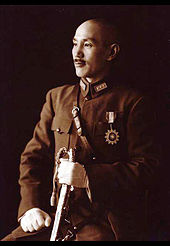 Chiang Kai-shek, who assumed the leadership of the Kuomintang after the death of Sun Yat-sen in 1925
Chiang Kai-shek, who assumed the leadership of the Kuomintang after the death of Sun Yat-sen in 1925
After Sun's death in March 1925, Chiang Kai-shek became the leader of the KMT. In 1926, Chiang led the Northern Expedition through China with the intention of defeating the warlords and unifying China. Chiang received the help of the Soviet Union; however he soon dismissed his Soviet advisors. He was convinced, not without reason, that they wanted to get rid of the Nationalists and take over control.[50] Chiang decided to strike first and purged the Communists, killing thousands of them. At the same time, other violent conflicts were taking place in China; in the South, where the Communists were in superior numbers, Nationalist supporters were being massacred. These events eventually led to the Chinese Civil War. Chiang Kai-shek pushed the Communists into the interior as he sought to destroy them, and established a government with Nanking as its capital in 1927.[51] By 1928, Chiang's army overturned the Peiyang government and unified the entire nation, at least nominally.
According to Sun Yat-sen's theory, the KMT was to rebuild China in three phases: a phase of military rule through which the KMT would take over power and reunite China by force; a phase of political tutelage; and finally a constitutional democratic phase.[52] In 1930, the Nationalists, having taken over the power, started the second phase, and promulgated a provisional constitution for the political tutelage period and began the period of so-called "tutelage".[53] They were criticized as instituting totalitarianism but claimed they were attempting to establish a modern democratic society. Among others, they created at that time the Academia Sinica, the Central Bank of China and other agencies. In 1932, China sent a team for the first time to the Olympic Games. Historians, such as Edmund Fung, argue that establishing a democracy in China at that time was not possible. The nation was at war and divided between Communists and Nationalists. Corruption within the government and lack of direction also prevented any significant reform from taking place. Chiang realized the lack of real work being done within his administration and told the State Council: "Our organization becomes worse and worse... many staff members just sit at their desks and gaze into space, others read newspapers and still others sleep."[54] The Nationalist government wrote a draft of the constitution in 5 May 1936.[55]
The Nationalists faced a new challenge with the Japanese invasion of Manchuria in 1931, with hostilities continuing through the Second Sino-Japanese War, part of World War II, from 1937 to 1945. The government of the Republic of China retreated from Nanking to Chungking (now Chongqing). In 1945, after the war of eight years, Japan surrendered and the Republic of China, under the name "China", became one of the founding members of the United Nations. The government returned to Nanking in 1946.
After World War II
Further information: Taiwan after World War II and Taiwan Strait CrisisAfter the defeat of Japan during World War II, Taiwan was surrendered to the Allies, with ROC troops accepting the surrender of the Japanese garrison. The government of the ROC proclaimed the "retrocession" of Taiwan to the Republic of China and established the provincial government at Taiwan. The military administration of the ROC extended over Taiwan, which led to widespread unrest and increasing tensions between Taiwanese and mainlanders.[56] The shooting of a civilian on 28 February 1947 triggered island-wide unrest, which was suppressed with military force in what is now called the 228 Incident. Mainstream estimates of casualties range from 18,000 to 30,000, mainly Taiwanese elites.[57][58] The 228 incident has had far-reaching effects on subsequent Taiwan history.
From 1945 to 1947, under United States mediation, especially through the Marshall Mission, the Nationalists and Communists agreed to start a series of peace talks aiming at establishing a coalition government. They however failed to reach an agreement and the civil war resumed.[59] In the context of political and military animosity, the National Assembly was summoned by the Nationalists without the participation of the Communists and promulgated the Constitution of the Republic of China. The constitution was criticized by the Communists,[60] and led to the final break between the two sides.[61] The full scale civil war resumed from early 1947.[62]
In 1948, the ROC administration imposed perpetual martial law.[34] Meanwhile, the civil war was escalating from regional areas to the entire nation. Eventually, the Communist troops, supported by the Soviet Union, defeated the ROC army, supported by the United States.
In October 1949, the Communists founded the People's Republic of China.[63]
In December 1949, Chiang evacuated the government to Taiwan and made Taipei the temporary capital of the ROC (also called the "wartime capital" by Chiang Kai-shek).[35][64] In his retreat, he also transferred China's gold reserves to Taiwan. Between one and two million refugees from mainland China followed him, adding to the earlier population of approximately six million.[34][65][66]
Government on Taiwan
See also: History of Taiwan With President Chiang Kai-shek, the U.S. President Dwight D. Eisenhower waved hands to Taiwanese people during his visit to Taipei, Taiwan in June 1960.
With President Chiang Kai-shek, the U.S. President Dwight D. Eisenhower waved hands to Taiwanese people during his visit to Taipei, Taiwan in June 1960.
 From the 1960s, Taiwan began rapidly developing and it became known as one of the Four Asian Tigers
From the 1960s, Taiwan began rapidly developing and it became known as one of the Four Asian Tigers
The ROC government, now threatened by both demands for independence within Taiwan, and by the Communists in mainland China, became increasingly dictatorial. The White Terror, started while the ROC central government was still governed from mainland China, remained in place until 1987 as a way to suppress the political opposition.[67] During these acts of violence, 140,000 Taiwan residents were imprisoned or executed for being perceived as anti-KMT or pro-Communist.[68]
Initially, the United States abandoned the KMT and expected that Taiwan would fall to the Communists. However, in 1950 the conflict between North Korea and South Korea, which had been ongoing since the Japanese withdrawal in 1945, escalated into full-blown war, and in the context of the Cold War, US President Harry S. Truman intervened again and dispatched the 7th Fleet into the Taiwan Straits to prevent hostilities between Taiwan and mainland China.[69] In the Treaty of San Francisco and the Treaty of Taipei, which came into force respectively on 28 April 1952 and 5 August 1952, Japan formally renounced all right, claim and title to Taiwan and Penghu, and renounced all treaties signed with China before 1942. The United States and the United Kingdom disagreed on whether the ROC or the PRC was the legitimate government of China—as a result both treaties remained silent about who would take control of the island.[70] Continuing conflict of the Chinese Civil War through the 1950s, and intervention by the United States notably resulted in legislations such as the Sino-American Mutual Defense Treaty and the Formosa Resolution of 1955.
During the 1960s and 1970s, the ROC maintained an authoritarian, single-party government while its economy became industrialized and technology oriented. This rapid economical growth, known as the Taiwan Miracle, was the result of a fiscal regime independent from mainland China and backed up, among others, by the support of US funds and demand for Taiwanese products.[71][72] In the 1970s, Taiwan was economically the second fastest growing state in Asia after Japan.[73] Taiwan, along with Hong Kong, South Korea and Singapore, became known as one of the Four Asian Tigers. Because of the Cold War, most Western nations and the United Nations regarded the ROC as the sole legitimate government of China until the 1970s. Later and especially after the termination of the Sino-American Mutual Defense Treaty, most nations switched diplomatic recognition to the PRC.
Up until the 1970s, the ROC was regarded by Western critics as undemocratic for upholding martial law, for severely repressing any political opposition and for controlling media. The KMT did not allow the creation of new parties and those that existed did not seriously compete with the KMT. Thus, competitive democratic elections did not exist.[74][75][76][77][78] From the late 1970s to the 1990s, however, reforms slowly moved the Republic of China from an authoritarian state to a democracy. In 1979, a pro-democracy protest known as the Kaohsiung Incident took place in Kaohsiung to celebrate Human Rights Day. Although the protest was rapidly crushed by the authorities, it is today considered as the main event that united Taiwan's opposition.[79] In 1986, Chiang Ching-kuo and Lee Teng-hui allowed for the creation of new political parties, which led to the founding of the first opposition party, the Democratic Progressive Party. In 1987, the martial law was lifted along with, a year later, the ban on new newspaper registration. The democratization process eventually led to the first direct presidential election by universal adult suffrage in 1996.[80][81]
Political status
Main article: Political status of TaiwanThe political status of the Republic of China is a contentious issue. The People's Republic of China (PRC) claims that the ROC government is illegitimate, referring to it as the "Taiwan Authority". The ROC, however, with its own constitution, independently elected president and a large army, continues to view itself as an independent sovereign state. Its current territory has never been controlled by the PRC.[82][83] Internationally, there is controversy on whether the ROC still exists as a state or a defunct state per international law due to the loss of membership/recognition in the United Nations and lack of wide diplomatic recognition. According to a poll taken by the TVBS in 2010, the majority of ROC residents—64%—opt for the status quo (i.e. no independence, no unification with mainland China), while 19% favor independence and 5% unification.[84]
Conflict with the PRC
See also: Cross-Strait relationsThe political environment is complicated by the potential for military conflict should overt actions toward independence or reunification be taken. It is the official PRC policy to use force to ensure reunification if peaceful reunification is no longer possible, as stated in its anti-secession law, and for this reason there are substantial military installations on the Fujian coast.[85][86] Although more recently the PRC has conducted to promote peaceful relation with the current ROC government and aimed at gradual reunification.
The PRC supports a version of the One-China policy, which states that Taiwan and mainland China are both part of China, and that the PRC is the only legitimate government of China. It uses this policy to prevent the international recognition of the ROC as an independent sovereign state. For its part, the People's Republic of China appears to find the retention of the name "Republic of China" more acceptable than an official declaration of an independent Taiwan. With the rise of the Taiwanese independence movement, the name "Taiwan" has been employed increasingly more often on the island.[87]
United States involvement
Main article: Republic of China-United States relationsThe United States is one of the main allies of the ROC and, since the Taiwan Relations Act passed in 1979, the United States has sold arms and provided military training to the Republic of China Armed Forces.[88] This situation continues to be an issue for the People's Republic of China which considers US involvement disruptive to the stability of the region. In January 2010, the Obama administration announced its intention to sell $6.4 billion worth of military hardware to Taiwan. As a consequence, the PRC threatened the US with economic sanctions and warned that their cooperation on international and regional issues could suffer.[89]
The official position of the United States is that the PRC is expected to "use no force or threat[en] to use force against Taiwan" and the ROC is to "exercise prudence in managing all aspects of Cross-Strait relations." Both are to refrain from performing actions or espousing statements "that would unilaterally alter Taiwan's status."[90]
Opinions within the ROC
See also: Taiwan independence and Chinese reunificationWithin the ROC, opinions are polarized between those supporting unification, represented by the Pan-Blue Coalition of parties, and those supporting independence, represented by the Pan-Green Coalition.
The KMT, the largest Pan-Blue party, supports the status quo for the indefinite future with a stated ultimate goal of unification. However, it does not support unification in the short term with the PRC as such a prospect would be unacceptable to most of its members and the public.[91] Ma Ying-jeou, former chairman of the KMT and the current ROC President, has set out democracy, economic development to a level near that of the ROC, and equitable wealth distribution as the conditions that the PRC must fulfill for reunification to occur.[92]
The DPP, the largest Pan-Green party, officially seeks independence, but in practice also supports the status quo because its members and the public would not accept the risk of provoking the PRC.[93][94]
Former President Chen Shui-bian of the Democratic Progressive Party stated during his years of administration that any decision should be decided through a public referendum of the people of the ROC. Both parties' current foreign policy positions support actively advocating ROC participation in international organizations, but while the KMT accepts the One-China principle, the DPP encourages the participation of Taiwan as a sovereign state.
On 2 September 2008, El Sol de México asked President Ma Ying-jeou about his views on the subject of "two Chinas" and if there was a solution for the sovereignty issues between the two. The ROC President replied that the relations are neither between two Chinas nor two states. It is a special relationship. Further, he stated that the sovereignty issues between the two cannot be resolved at present, but he quoted the "1992 Consensus", currently accepted by both sides, as a temporary measure until a solution becomes available.[95]
Government
Main article: Government of the Republic of ChinaThe Presidential Building in Taipei has housed the Office of the President of the Republic of China since 1950
The government of the Republic of China was founded on the Constitution of the ROC and its Three Principles of the People, which states that "[the ROC] shall be a democratic republic of the people, to be governed by the people and for the people."[96] The government is divided into five administrative branches (Yuan): the Control Yuan, the Examination Yuan, the Executive Yuan, the Judicial Yuan, and the Legislative Yuan. The Pan-Blue Coalition and Pan-Green Coalition are presently the dominant political blocs in the Republic of China.
President
The head of state and commander-in-chief of the armed forces is the President, who is elected by popular vote for a four-year term on the same ticket as the Vice-President. The President has authority over the Yuan. The President appoints the members of the Executive Yuan as his cabinet, including a Premier, who is officially the President of the Executive Yuan; members are responsible for policy and administration.[96]
Executive Yuan
The ROC's political system does not fit traditional models. The Premier is selected by the President without the need for approval from the Legislature, but the Legislature can pass laws without regard for the President, as neither he nor the Premier wields veto power.[96] Thus, there is little incentive for the President and the Legislature to negotiate on legislation if they are of opposing parties. After the election of the pan-Green's Chen Shui-bian as President in 2000, legislation repeatedly stalled because of deadlock with the Legislative Yuan, which was controlled by a pan-Blue majority.[97] Historically, the ROC has been dominated by strongman single party politics. This legacy has resulted in executive powers currently being concentrated in the office of the President rather than the Premier, even though the Constitution does not explicitly state the extent of the President's executive power.[98]
Legislature
The main legislative body is the unicameral Legislative Yuan with 113 seats. Seventy-three are elected by popular vote from single-member constituencies; thirty-four are elected based on the proportion of nationwide votes received by participating political parties in a separate party list ballot; and six are elected from two three-member aboriginal constituencies. Members serve three-year terms. Originally the unicameral National Assembly, as a standing constitutional convention and electoral college, held some parliamentary functions, but the National Assembly was abolished in 2005 with the power of constitutional amendments handed over to the Legislative Yuan and all eligible voters of the Republic via referendums.[96]
Judiciary
The Judicial Yuan is the ROC's highest judicial organ. It interprets the constitution and other laws and decrees, judges administrative suits, and disciplines public functionaries. The President and Vice-President of the Judicial Yuan and fifteen Justices form the Council of Grand Justices. They are nominated and appointed by the President of the Republic, with the consent of the Legislative Yuan. The highest court, the Supreme Court, consists of a number of civil and criminal divisions, each of which is formed by a presiding Judge and four Associate Judges, all appointed for life. In 1993, a separate constitutional court was established to resolve constitutional disputes, regulate the activities of political parties and accelerate the democratization process. There is no trial by jury but the right to a fair public trial is protected by law and respected in practice; many cases are presided over by multiple judges.[96]
Like most Asian democracies, the ROC still allows for capital punishment. Efforts have been made by the government to reduce the number of executions, although they have not been able to completely abolish the punishment. As of 2006, about 80% of Taiwanese want to keep the death penalty.[99]
Audit
The Control Yuan is a watchdog agency that monitors (controls) the actions of the executive. It can be considered a standing commission for administrative inquiry and can be compared to the Court of Auditors of the European Union or the Government Accountability Office of the United States.[96] The Control Yuan is sometimes also compared to an ombudsman or national human rights institution.
Examination
The Examination Yuan is in charge of validating the qualification of civil servants. It is based on the old Imperial examination system used in premodern China. It can be compared to the European Personnel Selection Office of the European Union or the Office of Personnel Management of the United States.[96]
Administrative regions
Main article: Administrative divisions of the Republic of ChinaSee also: TaiwanFirst-level division
According to the 1947 constitution, written and promulgated whilst the ROC government still controlled mainland China, the territory of the ROC consisted of provinces, special municipalities, as well as Mongolia[dubious ] and Tibet. Accordingly, when the ROC retreated to Taiwan in 1949, its claimed territory consisted of 35 provinces, 12 special municipalities, 1 special administrative region, as well as Mongolia[dubious ] and Tibet. However, the ROC has controlled only two provinces since its retreat – the Taiwan Province and some islands of Fujian Province. Moreover, these two provincial governments have been streamlined and transferred their function to the central government (Fujian since 1956 and Taiwan since 1998).
All 12 original special municipalities were located in mainland China which have mostly been repealed by the PRC when the government of the ROC retreated to Taiwan. Since its retreat, the ROC has founded 5 direct-controlled special municipalities out of territory initially belonging to Taiwan Province:
- Taipei City, formerly a provincial city of Taiwan Province, was elevated as a special municipality in 1967.
- Kaohsiung City, formerly a provincial city of Taiwan Province, was elevated as a special municipality in 1979. In 2010, a new Kaohsiung special municipality was established by merging former Kaohsiung County of Taiwan Province with the existing Kaohsiung City.
- New Taipei City, formerly Taipei County of Taiwan Province, was elevated as a special municipality in 2010.
- Taichung City was established by merging Taichung provincial city and Taichung County of Taiwan Province in 2010.
- Tainan City was established by merging Tainan provincial city and Tainan County of Taiwan Province in 2010.
The Republic of China also controls the Pratas Islands (Dong-Sha) and Taiping Island in the Spratly Islands, which are part of the disputed South China Sea Islands. They were placed under Kaohsiung administration after the retreat to Taiwan.[100]
Second-level division
Taiwan Province is divided into 12 counties and 3 provincial cities, while Fujian Province is divided into 2 counties.
Administrative divisions of the Republic of China (Taiwan) Special
MunicipalitiesTaiwan Province (streamlined) Fujian Province (streamlined) Provincial Cities Counties - Kaohsiung City
- New Taipei City
- Taichung City
- Tainan City
- Taipei City
- Chiayi City
- Hsinchu City
- Keelung City
- Penghu County
- Pingtung County
- Taitung County
- Taoyuan County
- Yilan County
- Yunlin County
Districts County-controlled cities and Townships See also: History of the political divisions of the Republic of China, Political divisions of Taiwan (1895-1945) According to Article 4 of the Local Government Act, laws pertaining to special municipalities also apply to counties with a population exceeding 2 million. Currently, this provision is applied to Taoyuan County.
Claimed territories
See also: Free Area of the Republic of ChinaThe ROC claimed to be the sole legitimate government of all China after its relocation to Taiwan in 1949 until the lifting of martial law in 1987. Although the administration of pro-independence President Chen Shui-bian (2000–2008) did not actively claim sovereignty over all of China, the national boundaries of the ROC have not been redrawn. Thus, the claimed area of the ROC continues to include mainland China, several off-shore islands, and Taiwan. The current President Ma Ying-jeou reasserted the ROC's claim to be the sole legitimate government of China and the claim that mainland China is part of ROC's territory.[101] He does not, however, actively seek reunification, and prefers to maintain an ambiguous status quo in order to improve relations with the PRC.[102]
In practice, although ROC law still formally recognizes residents of mainland China as citizens of the ROC, it makes a distinction between persons who have household residency in the "Free Area of the Republic of China" and those that do not, meaning that persons outside the area administered by the ROC must apply for special travel documents and cannot vote in ROC elections.
Politics
Main article: Politics of the Republic of ChinaSee also: Elections in the Republic of China and Human rights in the Republic of ChinaThe constitution of the Republic of China was drafted before the fall of mainland China to the Communists. It was created by the KMT for the purpose of all of its claimed territory, including Taiwan, even though the Chinese Communist party boycotted the drafting of the constitution. The constitution went into effect on 25 December 1947.[103]
The ROC remained under martial law from 1948 until 1987 and much of the constitution was not in effect. Political reforms beginning in the late 1970s and continuing through the early 1990s liberalized the ROC from an authoritarian one-party state into a multiparty democracy. Since the lifting of martial law, the Republic of China has democratized and reformed, suspending constitutional components that were originally meant for the whole of China. This process of amendment continues. In 2000, the Democratic Progressive Party (DPP) won the ROC presidency, ending the ROC's one-party rule history under the KMT. In May 2005, a new National Assembly was elected to reduce the number of parliamentary seats and implement several constitutional reforms. These reforms have been passed; the National Assembly has essentially voted to abolish itself and transfer the power of constitutional reform to the popular ballot.[104]
Major camps
Emblem of the Democratic Progressive Party, the main Pan-Green Coalition party.Emblem of the Kuomintang, the main Pan-Blue Coalition party.The political scene in the ROC is divided into two camps, with the pro-unification and center-right Kuomintang (KMT), People First Party (PFP), and New Party forming the Pan-Blue Coalition, and the pro-independence Democratic Progressive Party (DPP) and centrist Taiwan Solidarity Union (TSU) forming the Pan-Green Coalition.[105]
The Pan-Green camp tends to favor emphasizing the Republic of China as being a distinct country from the People's Republic of China. Thus, in September 2007, the then ruling Democratic Progressive Party approved a resolution asserting separate identity from China and called for the enactment of a new constitution for a "normal country". It called also for general use of "Taiwan" as the country's name, without abolishing its formal name, the "Republic of China".[106] Some members of the coalition, such as former President Chen Shui-bian, argue that it is unnecessary to proclaim independence because "Taiwan is already an independent, sovereign country" and the Republic of China is the same as Taiwan.[107] Native Taiwanese President Lee Teng-hui, whilst being part of the Pan-Blue coalition, also held a similar view and was a supporter of the Taiwanization movement during his presidency.[108]
Pan-Blue members generally support the concept of the One-China policy, which states that there is only one China and that its only government is the ROC. They favor eventual re-unification of China.[109] The more mainstream Pan-Blue position is to lift investment restrictions and pursue negotiations with the PRC to immediately open direct transportation links. Regarding independence, the mainstream Pan-Blue position is to maintain the status quo, while refusing immediate reunification.[91] President Ma Ying-jeou stated that there will be no unification nor declaration of independence during his presidency.[101][110] As of 2009, Pan-Blue members usually seek to improve relationships with mainland China, with a current focus on improving economic ties.[111]
Current political issues
The dominant political issue in the ROC is its relationship with the PRC. For almost 60 years, there were no direct transportation links, including direct flights, between Taiwan and mainland China. This was a problem for many Taiwanese businesses that had opened factories or branches in mainland China. The former DPP administration feared that such links would lead to tighter economic and political integration with mainland China, and in the 2006 Lunar New Year Speech, President Chen Shui-bian called for managed opening of links. Direct weekend charter flights between Taiwan and mainland China began in July 2008 under the current KMT government, and the first direct daily charter flights took off in December 2008.[112]
Other major political issues include the passage of an arms procurement bill that the United States authorized in 2001.[113] In 2008, however, the United States were reluctant to send over more arms to Taiwan out of fear that it would hinder the recent improvement of ties between the PRC and the ROC.[114] Another major political issue, is the establishment of a National Communications Commission to take over from the Government Information Office, whose advertising budget exercised great control over ROC media.[115]
The politicians and their parties have themselves become major political issues. Corruption among some DPP administration officials has been exposed. In early 2006, President Chen Shui-bian was linked to possible corruption. The political effect on President Chen Shui-bian was great, causing a divide in the DPP leadership and supporters alike. It eventually led to the creation of a political camp led by ex-DPP leader Shih Ming-teh which believes the president should resign. The KMT assets continue to be another major issue, as it was once the richest political party in the world.[116] Nearing the end of 2006, KMT's chairman Ma Ying-jeou was also hit by corruption controversies, although he has since then been cleared of any wrong-doings by the courts.[117] Since completing his second term as President, Chen Shui-bian has been charged with corruption and money laundering.[118]
The merger of the KMT and People First Party (PFP) was thought to be certain, but a string of defections from the PFP to the KMT have increased tensions within the Pan-Blue camp.[119][120]
National identity
Main articles: Taiwanese identity and Chinese nationalismRoughly 84% of Taiwan's population descends from Han Chinese who migrated from mainland China between 1661 and 1895. Another significant fraction descends from Han Chinese who immigrated from mainland China in the 1940s and 1950s. But between 1895 and the present, Taiwan and mainland China have shared a common government for only 4 years. The shared cultural origin combined with several hundred years of geographical separation, some hundred years of political separation and foreign influences, as well as hostility between the rival ROC and PRC have resulted in national identity being a contentious issue with political overtones. Since democratization and the lifting of martial law, a distinct Taiwanese identity (as opposed to Taiwanese identity as a subset of a Chinese identity) is often at the heart of political debates. Its acceptance makes the island distinct from mainland China, and therefore may be seen as a step towards forming a consensus for de jure Taiwan independence.[121] The pan-green camp supports a distinct Taiwanese identity, while the pan-blue camp supports a Chinese identity only.[109] The KMT has downplayed this stance in the recent years and now supports a Taiwanese identity as part of a Chinese identity.[122][123]
According to a survey conducted in March 2009, 49% of the respondents consider themselves as Taiwanese only, and 44% of the respondents consider themselves as Taiwanese and Chinese. 3% consider themselves as only Chinese.[84] Another survey, conducted in Taiwan in July 2009, showed that 82.8% of respondents consider that the ROC and the PRC are two separate countries developing each on its own.[124] A recent survey conducted in December 2009 showed that 62% of the respondents consider themselves as Taiwanese only, and 22% of the respondents consider themselves as both Taiwanese and Chinese. 8% consider themselves as only Chinese. The survey also shows that among 18–29 year old respondents, 75% consider themselves as Taiwanese only.[125]
Percentage of Taiwanese residents who consider themselves Taiwanese, Chinese or Taiwanese and Chinese according to various surveys. Survey Taiwanese Chinese Taiwanese and Chinese Research, Development, and Evaluation Commission, Executive Yuan (April 2008)[126] 67.1% 13.6% 15.2% TVBS Poll Center (June 2008)[126] 45% 4% 45% Common Wealth Magazine (December 2009)[125] 62% 8% 22% National Chengchi University (June 2010)[127] 51.6% 3.8% 40.4% TVBS Poll Center (March 2009)[84][128] 72% 16% (not an option for this question) TVBS Poll Center (March 2009)[84][129] 49% 3% 44% Foreign relations
Main article: Foreign relations of the Republic of ChinaBefore 1928, the foreign policy of Republican China was complicated by a lack of internal unity—competing centers of power all claimed legitimacy. This situation changed after the defeat of the Peiyang Government by the Kuomintang, which led to widespread diplomatic recognition of the Republic of China.[130] After the KMT retreat to Taiwan, most countries, notably the countries in the Western Bloc, continued to maintain relations with the ROC. Due to diplomatic pressure, recognition gradually eroded and many countries switched recognition to the PRC in the 1970s.
The ROC was a founding member of the United Nations and held China's seat on the Security Council until 1971, when it was expelled by General Assembly Resolution 2758 and replaced in all UN organs with the PRC. Multiple attempts by the ROC to rejoin the UN have not made it past committee.[131] The seat of China at the United Nations is currently occupied by the PRC.
Due to its limited international recognition, the Republic of China is a member of the Unrepresented Nations and Peoples Organization, represented by a ROC government funded organization, the Taiwan Foundation for Democracy (TFD) under the name "Taiwan".[132][133]
Diplomatic relations
 Countries maintaining diplomatic relations with the ROC
Countries maintaining diplomatic relations with the ROC diplomatic relations and embassy in Taipeiunofficial relations (see text)
diplomatic relations and embassy in Taipeiunofficial relations (see text)The PRC refuses to have diplomatic relations with any nation that recognizes the ROC, and requires all nations with which it has diplomatic relations to make a statement recognizing its claims to Taiwan.[134] As a result, there are only 23 states that have official diplomatic relations with the Republic of China. In practice, most countries view the ROC as an independent state and as such maintain unofficial relations with it.[135]
The ROC maintains unofficial relations with most countries via de facto embassies and consulates called Taipei Economic and Cultural Representative Offices (TECRO), with branch offices called "Taipei Economic and Cultural Offices" (TECO). Both TECRO and TECO are "unofficial commercial entities" of the ROC in charge of maintaining diplomatic relations, providing consular services (i.e. visa applications), and serving the national interests of the ROC in other countries.[136]
The United States maintains unofficial relations with the ROC through the instrumentality of the American Institute in Taiwan, which is the de facto embassy of the US in the ROC.[137]
Relations with Mongolia
Main article: Republic of China – Mongolia relationsBesides the dispute with the PRC over mainland China, the ROC also has a controversial relationship with Mongolia. Until 1945, the ROC claimed sovereignty over the country, but under Soviet pressure, it recognized Mongolian independence. Shortly thereafter in 1953, due to the deterioration of diplomatic relations with the Soviet Union, it revoked this recognition and kept considering it a part of mainland China.[138] In 2002, however, the DPP government under Chen Shui-bian declared that it recognized Mongolia's independence,[139] even though no legislative actions were taken to address concerns over its constitutional claims to Mongolia,[140] and established a representative office in Mongolia's capital, Ulan Bator. Offices established to support the ROC's claims over Outer Mongolia, such as the Mongolian and Tibetan Affairs Commission,[141] lie dormant.[142]
Participation in international events and organizations
Also due to its One China policy, the PRC only participates in international organizations where the ROC is not recognized as a sovereign country. Each year since 1992, the ROC has petitioned the UN for entry but has been unsuccessful. Most member states, including the United States, do not wish to discuss the issue of the ROC's political status for fear of souring diplomatic ties with the PRC.[143] However, both the US and Japan publicly support the ROC's bid for membership in the World Health Organization as an observer.[144] However, though the ROC has applied for WHO membership every year since 1997 under various denominations, their efforts have consistently been blocked by PRC.
At present, the ROC usually uses the politically neutral name "Chinese Taipei" in international events such as the Olympic Games where the PRC is also a party.[145] The ROC is typically barred from using its national anthem and national flag in international events due to PRC pressure; ROC spectators attending events such as the Olympics are often barred from bringing ROC flags into venues.[146] The ROC is able to participate as "China" in organizations that the PRC does not participate in, such as the World Organization of the Scout Movement.
The relationship with the PRC and the related issues of Taiwanese independence and Chinese reunification continue to dominate ROC politics.[147] For any particular resolution, public favor shifts greatly with small changes in wording, illustrating the complexity of public opinion on the topic.[148]
Military
Main article: Republic of China Armed ForcesSee also: Republic of China Military AcademyThe Republic of China Army takes its roots in the National Revolutionary Army, which was established by Sun Yat-sen in 1925 in Guangdong with a goal of reunifying China under the Kuomintang. When the People's Liberation Army won the Chinese Civil War, much of the National Revolutionary Army retreated to Taiwan along with the government. It was later reformed into the Republic of China Army. Units which surrendered and remained in mainland China were either disbanded or incorporated into the People's Liberation Army.
Today, the Republic of China maintains a large and technologically advanced military, mainly as defense against the constant threat of invasion by the PRC under the Anti-Secession Law of the People's Republic of China.[86] From 1949 to the 1970s, the primary mission of the military was to "retake the mainland." As this mission has shifted to defense, the ROC military has begun to shift emphasis from the traditionally dominant Army to the air force and navy. Control of the armed forces has also passed into the hands of the civilian government.[149] As the ROC military shares historical roots with the KMT, the older generation of high ranking officers tends to have Pan-Blue sympathies. However, many have retired and there are many more non-mainlanders enlisting in the armed forces in the younger generations, so the political leanings of the military have moved closer to the public norm in Taiwan.[150]
The ROC began a force reduction program to scale down its military from a level of 450,000 in 1997 to 380,000 in 2001.[151] As of 2009, the armed forces of the ROC number approximately 300,000,[152] with nominal reserves totaling 3.6 million as of 2005.[153] Conscription remains universal for qualified males reaching age eighteen, but as a part of the reduction effort many are given the opportunity to fulfill their draft requirement through alternative service and are redirected to government agencies or defense related industries.[154] Current plans call for a transition to a predominantly professional army over the next decade.[155][156] Conscription periods are planned to decrease from 14 months to 12.[157] In the last months of the Bush administration, Taipei took the decision to reverse the secular trend of declining defense spending, at a time when most Asian countries kept on reducing their military expenditures. It also decided to modernize both defensive and offensive capabilities. Taipei still keeps a large military apparatus relative to the island’s population: defense expenditures for 2008 were NTD 334 billion (approximately U.S. $10.5 billion), which accounted for 2.94% of GDP.
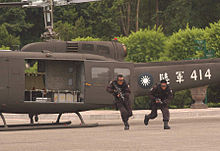 ROC Military Police special forces disembarking from a UH-1H helicopter from the ROC Army 602nd Air Cavalry Brigade during a counter-terrorism exercise (ROC Ministry of National Defense)
ROC Military Police special forces disembarking from a UH-1H helicopter from the ROC Army 602nd Air Cavalry Brigade during a counter-terrorism exercise (ROC Ministry of National Defense)
The armed forces' primary concern at this time is the possibility of an attack by the PRC, consisting of a naval blockade, airborne assault and/or missile bombardment. Four upgraded Kidd class destroyers were recently purchased from the United States, significantly upgrading Taiwan's air defense and submarine hunting abilities.[158] The Ministry of National Defense planned to purchase diesel-powered submarines and Patriot anti-missile batteries from the United States, but its budget has been stalled repeatedly by the opposition-Pan-Blue Coalition controlled legislature. The defense package was stalled from 2001–2007 where it was finally passed through the legislature and the US responded on 3 October 2008, with a $6.5 billion arms package including PAC III Anti-Air defense systems, AH-64D Apache Attack helicopters and other arms and parts.[159] A significant amount of military hardware has been bought from the United States, and, as of 2009, continues to be legally guaranteed by the Taiwan Relations Act.[88] In the past, France and the Netherlands have also sold military weapons and hardware to the ROC, but they almost entirely stopped in the 1990s under pressure of the PRC.[160][161]
The first line of defense against invasion by the PRC is the ROC's own armed forces. Current ROC military doctrine is to hold out against an invasion or blockade until the US military responds.[162] There is, however, no guarantee in the Taiwan Relations Act or any other treaty that the United States will defend Taiwan, even in the event of invasion.[163] The joint declaration on security between the US and Japan signed in 1996 may imply that Japan would be involved in any response. However, Japan has refused to stipulate whether the "area surrounding Japan" mentioned in the pact includes Taiwan, and the precise purpose of the pact is unclear.[164] The Australia, New Zealand, United States Security Treaty (ANZUS Treaty) may mean that other US allies, such as Australia, could theoretically be involved.[165] In practice, the risk of losing economic ties with China may prevent Australia from taking action.[166] The United States, United Kingdom, Japan, South Korea, Australia, Canada, Chile, and Peru conduct maritime exercises in the Pacific Ocean every 2 years called RIMPAC. They are conducted to promote stability and to be able to respond in case of an armed conflict in the region – that includes an invasion of Taiwan by China.[167]
Economy
Further information: Economy of TaiwanSee also: Taiwan MiracleThe quick industrialization and rapid growth of Taiwan during the latter half of the twentieth century has been called the "Taiwan Miracle". Taiwan is one of the "Four Asian Tigers" alongside Hong Kong, South Korea and Singapore.
By 1945, hyperinflation was in progress in mainland China and Taiwan as a result of the war with Japan. To isolate Taiwan from it, the Nationalist government created a new currency area for the island, and started a price stabilization program. These efforts helped significantly slow the inflation. In 1950, with the outbreak of the Korean War, the US began an aid program which resulted in fully stabilized prices by 1952.[168] The KMT government instituted many laws and land reforms that it had never effectively enacted on mainland China; it implemented a policy of import-substitution, and it attempted to produce imported goods domestically. Much of this was made possible through US economic aid, subsidizing the higher cost of domestic production.
Today the Republic of China has a dynamic, capitalist, export-driven economy with gradually decreasing state involvement in investment and foreign trade. In keeping with this trend, some large government-owned banks and industrial firms are being privatized.[169] Real growth in GDP has averaged about 8% during the past three decades. Exports have provided the primary impetus for industrialization. The trade surplus is substantial, and foreign reserves are the world's fifth largest.[170] The Republic of China has its own currency, the New Taiwan dollar.
Since the beginning of the 1990s, the economic ties between the ROC and the PRC have been very prolific. As of 2008, more than US$150 billion[171] have been invested in the PRC by Taiwanese companies, and about 10% of the Taiwanese labour force works in the PRC, often to run their own businesses.[172] Although the economy of Taiwan benefits from this situation, some have expressed the view that the island has become increasingly dependent on the PRC economy. A 2008 white paper by the Department of Industrial Technology states that "Taiwan should seek to maintain stable relation with China while continuing to protect national security, and avoiding excessive 'Sinicization' of Taiwanese economy."[173] Others argue that close economic ties between Taiwan and the PRC would make any military intervention by the PRC against Taiwan very costly, and therefore less probable.[174]
In 2001, agriculture constitutes only 2 percent of GDP, down from 35 percent in 1952.[175] Traditional labor-intensive industries are steadily being moved offshore and with more capital and technology-intensive industries replacing them. The ROC has become a major foreign investor in the PRC, Thailand, Indonesia, the Philippines, Malaysia, and Vietnam. It is estimated that some 50,000 Taiwanese businesses and 1,000,000 businesspeople and their dependents are established in the PRC.[176]
Because of its conservative financial approach and its entrepreneurial strengths, the ROC suffered little compared with many of its neighbors from the 1997 Asian Financial Crisis. Unlike its neighbors, South Korea and Japan, the Taiwanese economy is dominated by small and medium sized businesses, rather than the large business groups. The global economic downturn, however, combined with poor policy coordination by the new administration and increasing bad debts in the banking system, pushed Taiwan into recession in 2001, the first whole year of negative growth since 1947. Due to the relocation of many manufacturing and labor intensive industries to the PRC, unemployment also reached a level not seen since the 1970s oil crisis. This became a major issue in the 2004 presidential election. Growth averaged more than 4 percent in the 2002–2006 period and the unemployment rate fell below 4 percent.[177]
The ROC often joins international organizations under a politically neutral name. The ROC is a member of governmental trade organizations such as the World Trade Organization under the name Separate Customs Territory of Taiwan, Penghu, Kinmen and Matsu (Chinese Taipei) since 2002.[178]
Education
Main article: Education in TaiwanThe higher education system was established in Taiwan by Japan during the colonial period. However, after the Republic of China took over Taiwan from Japan in 1945, the system was promptly replaced by the same system as in mainland China which mixed with features of the Chinese and American educational systems.[179]
The educational system includes six years of elementary school, three years of middle school, three years of high school, and four years of university.[180] The system has been successful in that pupils in the ROC boast some of the highest test scores in the world, especially in mathematics and science;[181] However, it has also been criticized for placing excessive pressure on students and eschewing creativity in favor of rote memorization.[182][183]
Many Taiwanese students attend cram schools, or bushiban, to improve skills and knowledge on problem solving against exams of subjects like mathematics, nature science, history and many others. Courses are available for most popular subjects. Lessons are organized in lectures, reviews, private tutorial sessions, and recitations.[184][185]
As of 2003, the literacy rate in Taiwan is 96.1%.[137]
Demographics
Main article: Demographics of TaiwanSee also: Religion in TaiwanThe population of areas under control of the Republic of China was estimated in August 2009 at 23,082,125[137] spread across a total land area of 35,980 square kilometres (13,890 sq mi) making it the twelfth most densely populated country in the world with a population density of 640 /km2 (1,700 /sq mi). Ninety-eight percent of Taiwan's population is made up of Han Chinese while two percent are Austronesian aborigines. Taiwan is undergoing a decline in birth rates with a population growth of just 0.61% for the year 2006.
Religion
There are approximately 18,718,600 religious followers in Taiwan as of 2005 (81.3% of total population) and 14–18% are non-religious. According to the 2005 census, of the 26 religions recognized by the ROC government, the five largest are: Buddhism (8,086,000 or 35.1%), Taoism (7,600,000 or 33%), I-Kuan Tao (810,000 or 3.5%), Protestantism (605,000 or 2.6%), and Roman Catholicism (298,000 or 1.3%). But according to the CIA World Factbook and other latest sources from US State Department or the Religious Affairs Section of the MOI, over 80% to 93% of the population are nominal or cultural adherents of a Chinese traditional combination of Mahayana Buddhism, Confucianism (ancestor worship) and Taoism.[137][186][187][188]
Language
The official national language is Mandarin Chinese though the majority also speak Taiwanese (variant of the Hokkien speech of Fujian province) and many also speak Hakka.[189] Aboriginal languages are becoming extinct as the aborigines have become sinicized and the ROC government has not preserved the Formosan languages. Like Hong Kong and Macau, the ROC uses the Traditional Chinese writing system. However, in some rare cases, the characters are not the same as in Hong Kong or Macau.
Largest cities
See also: List of cities of the Republic of ChinaThe figures below are the 2011 estimates for the twenty largest urban populations within administrative city limits; a different ranking exists when considering the total metropolitan area populations (in such rankings the Taipei-Keelung metro area is by far the largest agglomeration).
Largest cities of Republic of China (Taiwan)
Source?Rank City Name Division Pop. Rank City Name Division Pop. 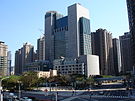
New Taipei
1 New Taipei New Taipei City 3,900,199 11 Changhua Changhua County 236,471 
Taichung
2 Kaohsiung Kaohsiung City 2,772,981 12 Pingtung Pingtung County 210,534 3 Taichung Taichung City 2,652,435 13 Pingzhen Taoyuan County 207,715 4 Taipei Taipei City 2,630,285 14 Bade Taoyuan County 176,843 5 Tainan Tainan City 1,873,193 15 Yangmei Taoyuan County 151,044 6 Hsinchu Hsinchu City 416,426 16 Zhubei Hsinchu County 143,341 7 Taoyuan Taoyuan County 407,757 8 Keelung Keelung City 382,551 9 Zhongli Taoyuan County 370,376 10 Chiayi Chiayi City 272,218 Public health
Main article: Healthcare in TaiwanHealth care in the ROC is managed by the Bureau of National Health Insurance (BNHI).[190]
The current program was implemented in 1995 and is considered social insurance. The government health insurance program maintains compulsory insurance for citizens who are employed, impoverished, unemployed, or victims of natural disasters with fees that correlate to the individual and/or family income; it also maintains protection for non-citizens working in Taiwan. A standardized method of calculation applies to all persons and can optionally be paid by an employer or by individual contributions.[191]
BNHI insurance coverage requires co-payment at the time of service for most services unless it is a preventative health service, for low-income families, veterans, children under three years old, or in the case of catastrophic diseases. Low income households maintain 100% premium coverage by the BNHI and co-pays are reduced for disabled or certain elderly peoples.
According to a recently published survey, out of 3,360 patients surveyed at a randomly chosen hospital, 75.1% of the patients said they are "very satisfied" with the hospital service; 20.5% said they are "okay" with the service. Only 4.4% of the patients said they are either "not satisfied" or "very not satisfied" with the service or care provided.[192]
Taiwan has its own Center for Disease Control, and during the SARS outbreak occurring in March 2003 confirmed 347 cases. During the outbreak the CDC and local governments set up monitored stations throughout public transportation, recreational sites and other public areas. With full containment in July 2003, there has not been a case of SARS since.[193] In 2004 the infant mortality rate was 5.3 with 15 physicians and 63 hospital beds per 10,000 people. The life expectancy for males was 73.5 years and 79.7 years for females according the World Health Report.
Other health related programs in Taiwan are the Centers for Disease Control[194] and the Department of Health.[195]
Calendar
 A calendar that commemorates the first year of the Republic as well as the election of Sun Yat-sen as the provisional President
A calendar that commemorates the first year of the Republic as well as the election of Sun Yat-sen as the provisional President Main article: Minguo calendar
Main article: Minguo calendarThe Republic of China uses two official calendars: the Gregorian calendar, and the Minguo calendar. The latter numbers years starting from 1911, the year of the founding of the Republic of China. For example, 2007 is the "96th year of the Republic".[196]
Months and days are numbered according to the Gregorian calendar. Year numbering may use the Gregorian system as well as the ROC era system. For example, 3 May 2004, may be written 2004-05-03 or 93–05–03. The use of two different calendar systems in Taiwan may be confusing, in particular for foreigners. For instance, products for export marked using the Minguo calendar can be misunderstood as having an expiration date 11 years earlier than intended.[197]
Taiwan also uses the lunar calendar for traditional festivals such as the Chinese New Year, the Lantern Festival, and the Dragon Boat Festival.[198]
International rankings
Main article: International rankings of TaiwanThe following are international rankings of the Republic of China:
Image gallery
Chiang Kai-shek Memorial Hall, TaipeiChiang Kai-shek Memorial Hall gateway by nightLongshan Temple, TaipeiDragon on the Longshan TempleLongyin Temple of Chukou Village in Alishan.National Concert HallXimending, Taipei by nightSee also
- Outline of the Republic of China
- Index of Republic of China-related articles
References
- ^ a b "Yearbook 2004". Government Information Office of the Republic of China. 2004. http://www.gio.gov.tw/taiwan-website/5-gp/yearbook/2004/P045.htm. "Taipei is the capital of the ROC"
- ^ "Taiwan (self-governing island, Asia)". Britannica Online Encyclopedia. 1975-04-05. http://www.britannica.com/EBchecked/topic/580902/Taiwan. Retrieved 2009-05-07.
- ^ "The Republic of China Yearbook 2009. Chapter 2 – People and Language". Government Information Office. 2009. http://www.gio.gov.tw/taiwan-website/5-gp/yearbook/ch02.html. Retrieved 2 May 2010.[dead link]
- ^ "The Republic of China Yearbook 2009 / Chapter 2: People and Language". Gio.gov.tw. http://www.gio.gov.tw/taiwan-website/5-gp/yearbook/ch02.html. Retrieved 1 August 2010.[dead link]
- ^ Taiwan entry at The World Factbook
- ^ Waishengren usually refers to people who moved from mainland China to Taiwan after 1949 when the KMT retreated to Taiwan due to the Chinese Civil War, and to their descendants born in Taiwan. It usually does not include citizens of the People's Republic of China who more recently moved to Taiwan.
- ^ Taiwanese Aborigines are officially categorised into 14 separate ethnic groups by the Republic of China. They have all been grouped into one group here for simplicity. For the entire list of groups, see List of ethnic groups in Taiwan
- ^ "The ROC's Humanitarian Relief Program for Afghan Refugees". Gio.gov.tw. 2001-12-11. Archived from the original on December 15, 2004. http://web.archive.org/web/20041215030432/http://www.gio.gov.tw/taiwan-website/5-gp/relief/help_41.htm. Retrieved 2009-05-07.
- ^ "Taiwanese health official invited to observe bird-flu conference". Gio.gov.tw. 2005-11-11. http://www.gio.gov.tw/taiwan-website/4-oa/20051111/2005111101.html. Retrieved 2009-05-07.
- ^ "Demonyms – Names of Nationalities". Geography.about.com. http://geography.about.com/library/weekly/aa030900a.htm. Retrieved 2009-05-07.
- ^ Although the territories controlled by the ROC imply that the demonym is "Taiwanese", some consider that it is "Chinese" due to the claims of the ROC over all of China. Taiwanese people have various opinions regarding their own national identity.
- ^ "MOI Statistical Information Service". http://sowf.moi.gov.tw/stat/month/m1-01.xls. Retrieved 2011-06-22.
- ^ a b c d "Republic of China (Taiwan)". International Monetary Fund. http://www.imf.org/external/pubs/ft/weo/2011/02/weodata/weorept.aspx?sy=2010&ey=2010&scsm=1&ssd=1&sort=country&ds=.&br=1&c=528&s=NGDPD%2CNGDPDPC%2CPPPGDP%2CPPPPC%2CLP&grp=0&a=&pr1.x=92&pr1.y=10. Retrieved 2011-09-20.
- ^ Regularly check CIA factbook or Household Income distribution of major countries. http://eng.stat.gov.tw/public/data/dgbas03/bs4/ninews_e/9808/t14e.xls.
- ^ a b Due to its political status, the UN has not calculated an HDI for the ROC. The ROC government calculated its HDI for 2010 to be 0.868, and would rank 18th among countries.
- ^ a b http://www.dgbas.gov.tw/public/Attachment/11715383471.doc
- ^ "ICANN Board Meeting Minutes". ICANN. 25 June 2010. http://brussels38.icann.org/meetings/brussels2010/transcript-board-25jun10-en.txt.
- ^ "Sea Surface Observation in the Taiwan Strait Using Satellite Imager from HRPT Station". Environmental Protection Agency, Republic of China. http://ivy3.epa.gov.tw/OMISAR/Data/OMISAR/wksp.mtg/WOM9/01-1445Kuo_rev.htm. Retrieved 2011-01-23.
- ^ The island of Taiwan covers an area of 36,008 km2 (13,902.8 sq mi). "Monthly Bulletin of Interior Statistics 2011.4" The total area under jurisdiction of the ROC (Free Area) covers around 36,191 km2 (13,973.4 sq mi).
- ^ "Chapter XIII. Fundamental National Policies". Office of the President of the Republic of China. http://english.president.gov.tw/Default.aspx?tabid=1118. Retrieved 2011-05-02. "The foreign policy of the Republic of China...in order to protect the rights and interests of Chinese citizens residing abroad"
- ^ "Country profile: Taiwan". BBC News. 2009-09-11. http://news.bbc.co.uk/1/hi/world/americas/country_profiles/1285915.stm. Retrieved 17 January 2010.
- ^ "China's Threats, Editorial". Washington Post. 2000-02-23. http://www.fapa.org/chinawp/chinathreatwp223.html. Retrieved 31 October 2011.
- ^ CIA World Factbook- GDP (PPP)
- ^ Chan, Rachel (17 June 2009). "Taiwan needs to boost public awareness on climate change: EU envoy". The China Post. http://www.chinapost.com.tw/life/environment/2009/06/17/212626/Taiwan-needs.htm. Retrieved 2009-07-22.
- ^ Yao, Grace; Yen-Pi Cheng and Chiao-Pi Cheng (6 October 2008). "The Quality of Life in Taiwan". Social Indicators Research 92 (The Quality of Life in Confucian Asia: From Physical Welfare to Subjective Well–Being). "a second place ranking in the 2000 Economist's world healthcare ranking"
- ^ "2010中華民國人類發展指數 (HDI)" (in Chinese) (pdf). Directorate General of Budget, Accounting and Statistics, Executive Yuan, R.O.C.. 2010. http://www.dgbas.gov.tw/public/Data/11715541971.pdf. Retrieved 2010-07-02.
- ^ "The Games of the Xth Olympiad, Los Angeles 1932, Official Report". LA84 Foundation. 1932. http://www.la84foundation.org/6oic/OfficialReports/1932/1932s.pdf.
- ^ Garver, John W. (April 1997). The Sino-American Alliance: Nationalist China and American Cold War Strategy in Asia. M.E. Sharp. ISBN 978-0-7656-0025-7. http://books.google.com/?id=SDqjW8G5H4cC.
- ^ "The Birth of the Republic of China". Government Information Office, ROC. http://www.gio.gov.tw/taiwan-website/5-gp/yearbook/ch3.html.[dead link]
- ^ "Chronologie internationale : Asie – La Documentation française" (in French). La documentation Française. http://www.ladocumentationfrancaise.fr/monde/chronologies/asie-2006.shtml. Retrieved 29 December 2009.
- ^ "Taiwán – Estados Unidos: Examinan el futuro de las relaciones Taipei-Washington". Gloobal. http://www.gloobal.net/iepala/gloobal/fichas/ficha.php?entidad=Textos&id=7001. Retrieved 2010-06-01.
- ^ "Taipei – Guida Turistica con informazioni turistiche sulla città". Paesionline.it. 2010-01-06. http://www.paesionline.it/asia/taiwan_taipei/guida_turistica_citta_taipei.asp. Retrieved 2010-06-01.
- ^ "Rüstungsstreit: Obama riskiert Eiszeit mit China – SPIEGEL ONLINE – Nachrichten – Politik". Spiegel.de. http://www.spiegel.de/politik/ausland/0,1518,675094,00.html. Retrieved 2010-06-01.
- ^ a b c "Taiwan Timeline – Retreat to Taiwan". BBC News. 2000. http://news.bbc.co.uk/hi/english/static/in_depth/asia_pacific/2000/taiwan_elections2000/1949_1955.stm. Retrieved 2009-06-21.
- ^ a b China: U.S. policy since 1945. Congressional Quarterly. 1980. ISBN 0871871882. "the city of Taipei became the temporary capital of the Republic of China"
- ^ Introduction to Sovereignty: A Case Study of Taiwan. Stanford Program on International and Cross-Cultural Education. 2004. http://www.taiwanbasic.com/edu/stanford-intro.htm. Retrieved 2010-02-25
- ^ "Growth in United Nations membership, 1945–present". http://www.un.org/en/members/growth.shtml.
- ^ Roy, Denny (2003). Taiwan: A Political History. Ithaca, New York: Cornell University Press. pp. 55, 56. ISBN 0-8014-8805-2.
- ^ "Decisive election win puts KMT back in power". ROC Central News Agency. 2008-03-22. http://www.globalsecurity.org/wmd/library/news/taiwan/2008/taiwan-080322-cna02.htm.
- ^ a b "The Chinese Revolution of 1911". US Department of State. http://www.state.gov/r/pa/ho/time/ip/88116.htm. Retrieved 2009-05-20.[dead link]
- ^ Trocki, Carl A. (1999). Opium, empire and the global political economy: a study of the Asian opium trade, 1750–1950. Routledge. p. 126. ISBN 0415199182. http://books.google.com/?id=DDNvkSC26bcC&pg=PA126&lpg=PA126.
- ^ Fenby 2009, pp. 89–94
- ^ Fairbank; Goldman. China. p. 235. ISBN 0690076126.
- ^ Fenby 2009, pp. 123–125
- ^ Fenby 2009, p. 131
- ^ Fenby 2009, pp. 136–138
- ^ Meyer, Kathryn; James H Wittebols, Terry Parssinen (2002). Webs of Smoke. Rowman & Littlefield. pp. 54–56. ISBN 074252003X. http://books.google.com/?id=RNknjDjfH6AC&pg=PA54.
- ^ Pak, Edwin; Wah Leung (2005). Essentials of Modern Chinese History. Research & Education Assoc.. pp. 59–61. ISBN 9780878914586. http://books.google.com/?id=BX04ZA8R9ugC&pg=PA59.
- ^ Guillermaz, Jacques (1972). A History of the Chinese Communist Party 1921–1949. Taylor & Francis. pp. 22–23. http://books.google.com/?id=WVEOAAAAQAAJ&pg=PA22.
- ^ Fenby 2009
- ^ "南京市". 重編囯語辭典修訂本. Ministry of Education, ROC. http://dict.revised.moe.edu.tw/cgi-bin/newDict/dict.sh?cond=%ABn%A8%CA%A5%AB&pieceLen=50&fld=1&cat=&serial=1&recNo=0&op=&imgFont=1. "民國十六年,國民政府宣言定為首都,今以臺北市為我國中央政府所在地。(In the 16th Year of the Republic of China [1927], the National Government established [Nanking] as the capital. At present, Taipei is the seat of the central government.)"
- ^ (Fung 2000, p. 30)
- ^ Chen, Lifu; Ramon Hawley Myers (1994). Hsu-hsin Chang, Ramon Hawley Myers. ed. The storm clouds clear over China: the memoir of Chʻen Li-fu, 1900–1993. Hoover Press. p. 102. ISBN 0817992723. http://books.google.com/?id=MOT_axUIWooC&pg=PA102. "After the 1930 mutiny ended, Chiang accepted the suggestion of Wang Ching-wei, Yen Hsi-shan, and Feng Yü-hsiang that a provisional constitution for the political tutelage period be drafted."
- ^ (Fung 2000, p. 5) "Nationalist disunity, political instability, civil strife, the communist challenge, the autocracy of Chiang Kai-shek, the ascendancy of the military, the escalating Japanese threat, and the "crisis of democracy" in Italy, Germany, Poland, and Spain, all contributed to a freezing of democracy by the Nationalist leadership."
- ^ 荆, 知仁 (in Simplified Chinese). 中华民国立宪史. 联经出版公司.
- ^ "This Is the Shame". Time Magazine. 1946-06-10. http://www.time.com/time/archive/preview/0,10987,792979,00.html.
- ^ "Snow Red & Moon Angel". Time Magazine. 1947-04-07. http://www.time.com/time/archive/preview/0,10987,804090,00.html.
- ^ "Taiwan Timeline – Civil War". BBC News. 2000. http://news.bbc.co.uk/hi/english/static/in_depth/asia_pacific/2000/taiwan_elections2000/1945_1949.stm. Retrieved 2009-06-21.
- ^ Inc, Time (1956). LIFE, Truman, China and History. 40. Time Inc. http://books.google.com/?id=hD8EAAAAMBAJ.
- ^ 评马歇尔离华声明,周恩来选集上卷,1947-1-10
- ^ 首都卫戍司令部,淞沪重庆警备司令,分别致电函京沪渝中共代表,所有中共人员限期全部撤退,重庆:大公报,1947-3-1
- ^ Westad, Odd Arne (2003). Decisive encounters: the Chinese Civil War, 1946–1950. ISBN 0804744785.
- ^ Kubek, Anthony (1963). How the Far East was lost: American policy and the creation of Communist China. ISBN 0856220000.
- ^ "A brief history of Taiwan" (in Chinese). Government Information Office, Republic of China. http://info.gio.gov.tw/ct.asp?xItem=27358&CtNode=2527&mp=21. Retrieved 2009-09-13. "1949年,國民政府退守臺灣後,以臺北為戰時首都"
- ^ Dunbabin, J. P. D. (2008). The Cold War. Pearson Education. p. 187. ISBN 0582423988. http://books.google.com/?id=IVriqPvx7iwC&pg=PA187. "In 1949 Chiang Kai-shek had transferred to Taiwan the government, gold reserve, and some of the army of his Republic of China."
- ^ Ng, Franklin (1998). The Taiwanese Americans. Greenwood Publishing Group. p. 10. ISBN 9780313297625. http://books.google.com/?id=lPzsB_wJQW0C&pg=PA10.
- ^ "28 February 1947 – Taiwan's Holocaust Remembered – 60th Commemoration". New Taiwan, Ilha Formosa. 2007. http://www.taiwandc.org/228-intr.htm. Retrieved 2009-07-02.
- ^ "Taiwan president apologises for 'white terror' era". Reuters. http://www.asiaone.com/News/AsiaOne%2BNews/Malaysia/Story/A1Story20080716-77050.html. Retrieved 2009-07-02.
- ^ US Department of Defense (1950). Classified Teletype Conference, dated 27 June 1950, between the Pentagon and General Douglas MacArthur regarding authorization to use naval and air forces in support of South Korea. Papers of Harry S. Truman: Naval Aide Files. Truman Presidential Library and Museum. p. 1 and 4. http://www.trumanlibrary.org/whistlestop/study_collections/korea/large/week1/kw_22_1.htm. "Page 1: In addition 7th Fleet will take station so as to prevent invasion of Formosa and to insure that Formosa not be used as base of operations against Chinese mainland." Page 4: "Seventh Fleet is hereby assigned to operational control CINCFE for employment in following task hereby assigned CINCFE: By naval and air action prevent any attack on Formosa, or any air or sea offensive from Formosa against mainland of China."
- ^ Alagappa, Muthiah (2001). Taiwan's presidential politics. M.E. Sharpe. p. 265. ISBN 9780765608345. http://books.google.com/?id=2Zx7nPeGWgwC&pg=PA265.
- ^ "Taiwan Timeline – Cold war fortress". BBC News. 2002. http://news.bbc.co.uk/hi/english/static/in_depth/asia_pacific/2000/taiwan_elections2000/1955_1972.stm. Retrieved 2009-07-02.
- ^ Woodward, Taiwanese hyperinflation, "Yet, the Chinese Nationalist government attempted to isolate Taiwan from the mainland inflation by creating it as an independent currency area. And during the later stages of the civil war it was able to end the hyperinflation on Taiwan, something it was unable to do on the mainland despite two attempts."
- ^ "China: Chiang Kai-shek: Death of the Casualty". TIME. 14 April 1975. p. 3. http://www.time.com/time/magazine/article/0,9171,917286-3,00.html. Retrieved 16 December 2009.
- ^ Sun, Yat-sen; Julie Lee Wei, Ramon Hawley Myers, Donald G. Gillin (1994). Julie Lee Wei, Ramon Hawley Myers, Donald G. Gillin. ed. Prescriptions for saving China: selected writings of Sun Yat-sen. Hoover Press. p. 36. ISBN 0817992812. http://books.google.com/?id=YA3TzmnYRpYC. "The party first applied Sun's concept of political tutelage by governing through martial law, not tolerating opposition parties, controlling the public media, and using the 1947 constitution drawn up on the China mainland to govern. Thus, much of the world in those years gave the ROC government low scores for democracy and human rights but admitted it had accomplished an economic miracle."
- ^ Chao, Linda; Ramon Hawley Myers (1997). Democracy's new leaders in the Republic of China on Taiwan. Hoover Press. p. 3. ISBN 0817938028. http://books.google.com/?id=tIiAd4MABAIC. "Although this party [the KMT] had initiated a democratic breakthrough and guided the democratic transition, it had also upheld martial law for thirty-six years and severely repressed political dissent and any efforts to establish an opposition party. [...] How was it possible that this party, so hated by opposition politicians and long regarded by Western critics as a dictatorial, Leninist-type party, still remained in power?"
- ^ (Fung 2000, p. 67) "Nanjing was not only undemocratic and repressive but also inefficient and corrupt. [...] Furthermore, like other authoritarian regimes, the GMD sought to control people's mind."
- ^ (Fung 2000, p. 85) "The response to national emergency, critics argued, was not merely military, it was, even more important, political, requiring the termination of one-party dictatorship and the development of democratic institutions."
- ^ Copper, John Franklin (2005). Consolidating Taiwan's democracy. University Press of America. p. 8. ISBN 0761829776. http://books.google.com/?id=761bWuEtEfEC. "Also, the "Temporary Provisions" (of the Constitution) did not permit forming new political parties, and those that existed at this time did not seriously compete with the Nationalist Party. Thus, at the national level the KMT did not permit competitive democratic elections."
- ^ "Out with the old". BBC News. 2002. http://news.bbc.co.uk/hi/english/static/in_depth/asia_pacific/2000/taiwan_elections2000/1972_1986.stm. Retrieved 2009-10-30.
- ^ "Taiwan Timeline – Out with the old". BBC News. 2002. http://news.bbc.co.uk/hi/english/static/in_depth/asia_pacific/2000/taiwan_elections2000/1972_1986.stm. Retrieved 2009-07-03.
- ^ "Taiwan Timeline – Path to democracy". BBC News. 2002. http://news.bbc.co.uk/hi/english/static/in_depth/asia_pacific/2000/taiwan_elections2000/1986_1999.stm. Retrieved 2009-07-03.
- ^ "The One-China Principle and the Taiwan Issue". PRC Taiwan Affairs Office and the Information Office of the State Council. 2005. http://www.gwytb.gov.cn:8088/detail.asp?table=WhitePaper&title=White%20Papers%20On%20Taiwan%20Issue&m_id=4. Retrieved 2006-03-06.[dead link] Section 1: "Since the KMT ruling clique retreated to Taiwan, although its regime has continued to use the designations "Republic of China" and "government of the Republic of China," it has long since completely forfeited its right to exercise state sovereignty on behalf of mainland China and, in reality, has always remained only a separate state on the island of Taiwan."
- ^ BBC News, "Taiwan Flashpoint", "But Taiwan's leaders say it is clearly much more than a province, arguing that it is a sovereign state. It has its own constitution, democratically elected leaders, and 400,000 troops in its armed forces."
- ^ a b c d "ECFA issues and the nationality identification". TVBS. http://www.tvbs.com.tw/FILE_DB/DL_DB/yijung/200905/yijung-20090508145032.pdf.
- ^ "Liancheng / Lianfeng Airbase – Chinese Military Forces". Federation of American Scientists. http://www.fas.org/nuke/guide/china/facility/liancheng.htm. Retrieved 2009-06-07. "In March 2000 it was reported that the PLA Air Force was deploying new air-defense missiles [possibly batteries of Russian-made S-300 missiles] opposite Taiwan at the coastal cities of Xiamen and Shantou, and at Longtian, near Fuzhou."
- ^ a b "2004 National Defense Report" (PDF). ROC Ministry of National Defense. 2004. pp. 89–90. Archived from the original on March 11, 2006. http://web.archive.org/web/20060311012134/http://report.mnd.gov.tw/eng/pdf/all-1-360.pdf. Retrieved 2006-03-05. "The PRC refusal to renounce using military power against Taiwan, its current emphasis on 'enhancing preparation for military struggle', its obvious intention of preparing a war against Taiwan reflected in operational deployment, readiness efforts, and annual military exercises in the Southeast China coastal region, and its progress in aerospace operations, information warfare, paralyzing warfare, and non-conventional warfare, all of these factors work together so that the ROC Armed Forces face an increasingly complicated and difficult situation in terms of self-defense and counterattack. These multiple daunting challenges are testing our defense security."
- ^ Macartney, Jane (6 March 2007). "War of words after call for independence". London: Times Online. http://www.timesonline.co.uk/tol/news/world/asia/article1475250.ece. Retrieved 2009-06-04.
- ^ a b Yates, Stephen J. (16 April 1999). "The Taiwan Relations Act After 20 Years: Keys to Past and Future Success". The Heritage Foundation. http://www.heritage.org/research/asiaandthepacific/bg1272.cfm. Retrieved 2009-07-19.
- ^ "China: US spat over Taiwan could hit co-operation". Agence France Presse. February 2, 2010. http://www.google.com/hostednews/afp/article/ALeqM5jDzKLVZ7X2dz8yrsshklcJZh38Cg.
- ^ "Overview of US Policy Towards Taiwan" (Press release). US Department of State. 2004-04-21. http://www.state.gov/p/eap/rls/rm/2004/31649.htm.[dead link]
- ^ a b "Looking behind Ma's 'three noes'". Taipei Times. 2008-01-21. http://www.taipeitimes.com/News/editorials/archives/2008/01/21/2003398185. Retrieved 2009-05-28.
- ^ Enav, Peter (2008-05-16). "Unification with China unlikely ‘in our lifetimes’: president-elect". The China Post. http://www.chinapost.com.tw/taiwan/national/national%20news/2008/05/16/156644/Unification-with.htm. Retrieved 2009-06-13. "'It is very difficult for us to see any unification talks even in our lifetimes,' Ma said. 'Taiwanese people would like to have economic interactions with the mainland, but obviously they don’t believe their political system is suitable for Taiwan.'"
- ^ Eckholm, Erik (2000-03-22). "Why a Victory in Taiwan Wasn't Enough for Some – The New York Times". The New York Times. http://www.nytimes.com/2000/03/22/world/why-a-victory-in-taiwan-wasn-t-enough-for-some.html. Retrieved 2009-05-28.
- ^ BBC News, "Taiwan Flashpoint", "Since neither outcome looks likely in the short or even medium term, it is perhaps not surprising that opinion polls suggest most Taiwanese people want things to stay as they are, with the island's ambiguous status unresolved."
- ^ "Impulsa Taiwan la reconciliación" (in Spanish). El Sol de México. 2008-09-02. http://www.oem.com.mx/oem/notas/n836891.htm. Retrieved 2009-06-09. "Esencialmente, no definiríamos la relación a través del estrecho de Taiwan como una relación de dos países o dos Chinas, porque nuestra Constitución no lo permite. Nosotros definiríamos está relación como una relación muy especial, ya que la Constitución nuestra, igual que la Constitución de China continental, no permite la existencia de otro país dentro del territorio."
- ^ a b c d e f g "The Republic of China Yearbook 2008 / CHAPTER 4 Government". Government Information Office, Republic of China (Taiwan). 2008. http://www.gio.gov.tw/taiwan-website/5-gp/yearbook/ch4.html. Retrieved 2009-05-28.[dead link]
- ^ "Letter: KMT holds the key". Taipei Times. 2006-09-14. http://www.taipeitimes.com/News/editorials/archives/2006/09/14/2003327608. Retrieved 2009-05-28.
- ^ Jayasuriya, Kanishka (1999). Law, capitalism and power in Asia. Routledge. p. 217. ISBN 9780415197434. http://books.google.com/?id=OqGSrD9QhXcC&pg=PA217.
- ^ Chang, Rich (2006-01-02). "Nation keeps death penalty, but reduces executions". Taipei Times. http://www.taipeitimes.com/News/taiwan/archives/2006/01/02/2003287050. Retrieved 2009-11-02.
- ^ "World: Asia-Pacific Analysis: Flashpoint Spratly". BBC. 1999-02-14. http://news.bbc.co.uk/2/hi/asia-pacific/279170.stm.
- ^ a b "Ma refers to China as ROC territory in magazine interview". Taipei Times. 2008-10-08. http://www.taipeitimes.com/News/taiwan/archives/2008/10/08/2003425320.
- ^ MacArtney, Jane (2008-08-30). "President Ma Ying-jeou of Taiwan has progress making ties with China". The Times (London). http://www.timesonline.co.uk/tol/news/world/asia/article4636572.ece.
- ^ Ginsburg, Tom (2003). Judicial review in new democracies. Cambridge University Press. p. 111. ISBN 0521520398. http://books.google.com/?id=qJrsouEjOZEC&pg=PA111.
- ^ "Taiwan assembly passes changes". BBC News. 2005-06-07. http://news.bbc.co.uk/2/hi/asia-pacific/4616043.stm.
- ^ BBC News, "Taiwan Flashpoint", "Officially, the DPP still favours eventual independence for Taiwan, while the KMT favours eventual re-unification."
- ^ "Taiwan party asserts separate identity from China". USATODAY.Com. 2007-09-30. http://www.usatoday.com/news/world/2007-09-30-taiwan_N.htm. Retrieved 2009-05-29.
- ^ Crisis Group (6 June 2003). "Taiwan Strait I: What's Left of 'One China'?". International Crisis Group. Archived from the original on July 9, 2008. http://web.archive.org/web/20080709035143/http://www.crisisgroup.org/home/index.cfm?id=1653&l=1. Retrieved 2009-05-29.
- ^ Shirk, Susan L. (2007). China: Fragile Superpower. Oxford University Press. ISBN 9780195306095.
- ^ a b Pares, Susan (2005-02-24). A political and economic dictionary of East Asia. Routledge. p. 267. ISBN 978-1-85743-258-9. http://books.google.com/?id=xJKePP5ATKUC. "The Pan-Blue coalition on the whole favours a Chinese nationalist identity and policies supporting reunification and increased economic links with the People's Republic of China."
- ^ "Taiwan and China in 'special relations': Ma". China Post. 2008-09-04. http://www.chinapost.com.tw/taiwan/china-taiwan%20relations/2008/09/04/173082/Taiwan-and.htm.
- ^ "World | Asia-Pacific | Taiwan opposition leader in China". BBC News. 2005-04-26. http://news.bbc.co.uk/1/hi/world/asia-pacific/4482617.stm. Retrieved 2009-05-28.
- ^ Yu, Sophie; Jane Macartney (16 December 2008). "Direct flights between China and Taiwan mark new era of improved relations". London: Times Online. http://www.timesonline.co.uk/tol/news/world/asia/article5346905.ece. Retrieved 2009-06-04.
- ^ Michael S. Chase (2008-09-04). "Caliber – Asian Survey – 48(4):703 – Abstract". Caliber.ucpress.net. doi:10.1525/as.2008.48.4.703. http://caliber.ucpress.net/doi/abs/10.1525/as.2008.48.4.703?journalCode=as. Retrieved 2009-05-29.
- ^ "US Keeps Taiwan at Arm's Length | David Isenberg | Cato Institute: Commentary". Cato.org. http://www.cato.org/pub_display.php?pub_id=9556. Retrieved 2009-05-29.
- ^ "NCC relinquishes power over China-related media". Taipei Times. 2007-08-09. http://www.taipeitimes.com/News/taiwan/archives/2007/08/09/2003373313. Retrieved 2009-05-29.
- ^ Bristow, Michael (2001-10-26). Wealth probe for 'world's richest' party. BBC News Online. http://news.bbc.co.uk/2/hi/asia-pacific/1621048.stm. Retrieved 2007-11-12
- ^ "Court clears Ma of graft charges". The China Post. 2008-04-25. http://www.chinapost.com.tw/taiwan/2008/04/25/153499/Court-clears.htm. Retrieved 2009-05-29.
- ^ "Chen Shui-bian lied about Lien Chan-endorsed check". The China Post. 2008-10-03. http://www.chinapost.com.tw/taiwan/national/national%20news/2008/10/03/177135/Chen-Shui-bian.htm. Retrieved 2009-05-29.
- ^ "No headway in KMT, PFP merger talks". China Daily. http://www.chinadaily.com.cn/english/doc/2005-12/13/content_502869.htm. Retrieved 2009-05-29.
- ^ "PFP rejects merger with KMT". Taipei Times. 2002-05-01. http://www.taipeitimes.com/News/archives/2002/05/01/0000134077. Retrieved 2009-05-29.
- ^ Shambaugh, David L. (2006). Power shift. University of California Press. pp. 179–183. ISBN 0520245709. http://books.google.com/?id=rMicZHVR_y4C&pg=PA179.
- ^ Okazaki, Hisahiko (30 December 2008). "No sign of a 'peace agreement'". The Japan Times Online. http://search.japantimes.co.jp/cgi-bin/eo20081230ho.html. Retrieved 2009-07-15. "For one thing, I believe there is recognition that the awareness of Taiwanese identity is now irreversible. The KMT government did things like rename the "Taiwan Post" to "Chunghwa Post" as soon as it came in. But it did not take much time to perceive that it would cause a backlash among the Taiwan populace. The cross-strait exchanges have also brought about opposition demonstrations from time to time. This appears to be one of the reasons for the abrupt decline in the approval rating of the Ma administration."
- ^ "10 Questions: Ma Ying-jeou". TIME. 10 July 2006. http://www.time.com/time/magazine/article/0,9171,1211639,00.html. Retrieved 2009-07-15. "I am Taiwanese as well as Chinese."
- ^ "Survey on President Ma’s Approval Rating and Cross-Strait Relations After First Year of Direct Flights". Global Views Survey Research Center. 24 July 2009. http://www.gvm.com.tw/gvsrc/200907_GVSRC_others_E.pdf. Retrieved 23 December 2009.
- ^ a b "天下雜誌民調顯示:6成1民眾擔心經濟傾中 7成5年輕人自認台灣人" (in Traditional Chinese). http://www.libertytimes.com.tw/2009/new/dec/16/today-t1.htm. Retrieved 2010-01-10.
- ^ a b "附表十二:民眾對自我認同的看法" (in Traditional Chinese). http://www.mac.gov.tw/public/Attachment/973944270.pdf. Retrieved 2010-04-27.
- ^ "資料庫─台灣民眾 台灣人/中國人認同趨勢分布" (in Traditional Chinese). National Chengchi University. http://esc.nccu.edu.tw/modules/tinyd2/content/TaiwanChineseID.htm. Retrieved 2009-05-07.
- ^ Quote: "Table 12: In Taiwan, some people identify themselves as Chinese, some identify themselves as Taiwan (sic). Do you identify yourself as Taiwanese or Chinese? (Do not prompt both Taiwanese and Chinese)"
- ^ Quote: "Table 13: In Taiwan, some people identify themselves as Chinese, some identify themselves as Taiwan (sic). Do you identify yourself as Taiwanese, Chinese or both Taiwanese and Chinese?"
- ^ "Countries – China". US Department of State, Office of the Historian. http://history.state.gov/countries/china. Retrieved 2009-05-28.
- ^ "Taiwan and the United Nations". New Taiwan. http://www.taiwandc.org/un-2001.htm. Retrieved 2009-05-28.
- ^ "Taiwan". UNPO. http://www.unpo.org/content/view/7908/146/. Retrieved 2009-05-07.
- ^ "About TFD". TFD. http://www.tfd.org.tw/english/about.php.
- ^ Henckaerts, Jean-Marie (1996). The international status of Taiwan in the new world order. Martinus Nijhoff Publishers. pp. 96–97. ISBN 9041109293. http://books.google.com/?id=_9kuVIayxDoC&pg=PA96.
- ^ BBC News, "Taiwan Flashpoint", "Given the huge divide between these two positions, most other countries seem happy to accept the current ambiguity, whereby Taiwan has most of the characteristics of an independent state, even if its legal status remains unclear."
- ^ Vang, Pobzeb (2008). Five Principles of Chinese Foreign Policies. AuthorHouse. p. 46. ISBN 9781434369710. http://books.google.com/?id=TvXlFsxmJiMC.
- ^ a b c d "Taiwan". CIA – The World Factbook. 2009-04-09. https://www.cia.gov/library/publications/the-world-factbook/geos/tw.html. Retrieved 2009-04-22.
- ^ Green, Robert (2003-01-01). "Onward to Mongolia". Government Information Office, Republic of China (Taiwan). http://taiwanreview.nat.gov.tw/ct.asp?xItem=798&CtNode=128. Retrieved 2009-08-03.
- ^ "Mongolian office to ride into Taipei by end of the year". Taipei Times. 2002-10-11. http://www.taipeitimes.com/News/archives/2002/10/11/0000175237. Retrieved 2009-05-28. "In October 1945, the people of Outer Mongolia voted for independence, gaining the recognition of many countries, including the Republic of China. (...) Due to a souring of relations with the Soviet Union in the early 1950s, however, the ROC revoked recognition of Outer Mongolia, reclaiming it as ROC territory."
- ^ "ASIA-PACIFIC | Taiwan 'embassy' changes anger China". BBC News. 2002-02-26. http://news.bbc.co.uk/1/hi/world/asia-pacific/1842387.stm. Retrieved 2009-05-28.
- ^ "The History of MTAC". Mongolian & Tibetan Affairs Commission. http://www.mtac.gov.tw/pages.php?lang=5. Retrieved 2009-05-07.
- ^ "Taiwan-Mongolia ties move on". The Taipei Times. 2002-09-10. http://www.taipeitimes.com/News/taiwan/archives/2002/09/10/167505.
- ^ "JOHN TKACIK ON TAIWAN: Taiwan’s ‘undetermined’ status". Taipei Times. 2009-05-13. http://www.taipeitimes.com/News/editorials/archives/2009/05/13/2003443455. Retrieved 2009-05-28.
- ^ "WHO application: a question of health or politics?". The Taipei Times. 2004-05-19. http://www.taipeitimes.com/News/taiwan/archives/2004/05/19/2003156094.
- ^ "Taiwan insists on 'Chinese Taipei'". The China Post. 2008-07-25. http://www.chinapost.com.tw/taiwan/china-taiwan%20relations/2008/07/25/167036/Taiwan-insists.htm. Retrieved 2009-05-28.
- ^ "Taiwan flags in S.L. ruffle a few feelings". The Deseret News. 2002-02-10. http://deseretnews.com/oly/view/0,3949,70000298,00.html.
- ^ "The Official Position of the Republic of China on China’s Passing of the Anti-secession (Anti-Separation) Law" (Press release). Mainland Affairs Council, ROC Executive Yuan. 2005-03-29. http://www.mac.gov.tw/ct.asp?xItem=68048&ctNode=5910&mp=3. "Section II-2: "'The Republic of China is an independent and sovereign state. Taiwan's sovereignty belongs to the 23 million people of Taiwan. Only the 23 million citizens of Taiwan may decide on the future of Taiwan.' This statement represents the greatest consensus within Taiwan's society today concerning the issues of national sovereignty and the future of Taiwan. It is also a common position shared by both the ruling and opposition parties in Taiwan. A recent opinion poll shows that more than 90% of the people of Taiwan agree with this position."
- ^ Michael D. Swaine; James C. Mulvenon (2001) [2001]. "3" (PDF). Taiwan's Foreign and Defense Policies: Features and Determinants. RAND Corporation. p. 30. ISBN 0-8330-3094-9. http://www.rand.org/pubs/monograph_reports/MR1383/MR1383.ch3.pdf. Retrieved 2006-03-05. "Efforts to accurately measure and assess public and group views and interests on these and other issues are fraught with problems, however, such as political bias and the use of unscientific methodologies. A significant number of opinion polls are conducted each year by Taiwan’s political parties, newspapers, and various politically oriented private groups or foundations on a wide range of subjects. Many such polls arguably produce inaccurate results, either as a result of sampling errors, biased questions, or a subject’s awareness of the highly partisan nature of the polling agency."
- ^ "Committed to Taiwan". The Wall Street Journal. 2001-04-26. http://online.wsj.com/article/SB988242686540854310.html?mod=googlewsj. Retrieved 2009-05-28.
- ^ Swaine 2001, p. 65, "The ROC military functioned until very recently as an instrument of KMT rule [and] the bulk of the officer corps is still composed of Mainlanders, many of whom allegedly continue to support the values and outlook of more conservative KMT and New Party members. This is viewed as especially the case among the senior officers of the ROC Army. Hence, many DPP leaders insist that the first step to building a more secure Taiwan is to bring the military more fully under civilian control, to remove the dominant influence of conservative KMT elements, and to reduce what is regarded as an excessive emphasis on the maintenance of inappropriate ground force capabilities, as opposed to more appropriate air and naval capabilities."
- ^ "Taiwan Yearbook 2004". Government Information Office, Republic of China. http://www.gio.gov.tw/taiwan-website/5-gp/yearbook/2004/P101.htm. Retrieved 2009-05-28.
- ^ Bishop, Mac William (2004-01-01). "Women Take Command". Government Information Office, Republic of China. http://www.gio.gov.tw/ct.asp?xItem=28601&ctNode=3389. Retrieved 2009-06-05.
- ^ "Taiwan Yearbook 2005". Government Information Office, Republic of China. http://www.gio.gov.tw/taiwan-website/5-gp/yearbook/2005/p104.html. Retrieved 2009-05-28.
- ^ "ASIA-PACIFIC | Military alternative in Taiwan". BBC News. 2000-05-01. http://news.bbc.co.uk/1/hi/world/asia-pacific/729500.stm. Retrieved 2009-05-28.
- ^ "The myth: a professional military in five years". Taipei Times. 2009-03-21. http://www.taipeitimes.com/News/editorials/archives/2009/03/21/2003439010/wiki. Retrieved 2009-05-28.
- ^ "Taiwan to end conscription". The Straits Times. 2009-03-09. http://www.straitstimes.com/print/Breaking%2BNews/Asia/Story/STIStory_347888.html. Retrieved 2009-05-28.
- ^ "Taiwan to shorten conscription term to one year". Central News Agency website, Taipei. 2008-12-03. http://nl.newsbank.com/nl-search/we/Archives?p_product=NewsLibrary&p_multi=BBAB&d_place=BBAB&p_theme=newslibrary2&p_action=search&p_maxdocs=200&p_topdoc=1&p_text_direct-0=124D9E23B9033ED0&p_field_direct-0=document_id&p_perpage=10&p_sort=YMD_date:D&s_trackval=GooglePM. Retrieved 2009-05-28.
- ^ "Kidd-class warships set sail for Taiwan". The Taipei Times. 2005-10-31. http://www.taipeitimes.com/News/taiwan/archives/2005/10/31/2003278135.
- ^ Rickards, Jane (2008-10-05). "Taiwanese leader hails weapons deal with US". The Washington Post. http://www.washingtonpost.com/wp-dyn/content/article/2008/10/04/AR2008100400477.html.
- ^ Cabestan, Jean-Pierre (2001). "France's Taiwan Policy: A Case of Shopkeeper Diplomacy". CERI. http://www.ceri-sciencespo.com/archive/july01/jpcabest.pdf. Retrieved 2009-06-05. "By excluding the French companies from the bidding lists of many contract, Peking wanted above all to stop a growing trend (...) to disregard its objections and interests in the Taiwan issue. (...) In spite of the ban of arms sales to Taiwan approved by the French government in January 1994, discreet and small-sized deals have continued to be concluded since then."
- ^ "Taiwan trying to shore up weapons support". USATODAY.com. 2004-09-24. http://www.usatoday.com/news/world/2004-09-24-taiwan_x.htm. Retrieved 2009-05-28.
- ^ Swaine, Michael; James C. Mulvenon (2001) [2001] (PDF). Taiwan's Foreign and Defense Policies: Features and Determinants. RAND Corporation. ISBN 0-8330-3094-9. http://www.rand.org/pubs/monograph_reports/MR1383/MR1383.ch3.pdf. Retrieved 2006-03-05.
- ^ "China Threat to Attack Taiwan Alarms Asia". Associated Press. 2005-03-14. http://sfgate.com/cgi-bin/article.cgi?f=/n/a/2005/03/14/international/i003051S91.DTL.[dead link]
- ^ Kapstein, Ethan B.; Michael Mastanduno (1999). Unipolar politics. Columbia University Press. p. 194. ISBN 0231113099. http://books.google.com/?id=68s2k0ztkCMC&pg=PA194. "The Japanese leadership openly split on whether a crisis in Taiwan was included in the geographic expression "area surrounding Japan." In the event, Japan refused to stipulate the contingencies under which it would provide rear area support for U.S. forces or even the geographic scope of the "area surrounding Japan". (...) The two sides have not articulated clearly what the alliance stands for, nor who it is defined to protect against."
- ^ Tow, William (2005). "ANZUS: Regional versus Global Security in Asia?". International Relations in the Asia-Pacific 5 (2): 197. doi:10.1093/irap/lci113.
- ^ "China and Taiwan: flashpoint for a war". The Sydney Morning Herald. 2004-07-14. http://www.smh.com.au/articles/2004/07/13/1089694360063.html. Retrieved 2009-06-13.
- ^ Lotta Danielsson-Murphy. "ECFA poses new risks for Taiwan-Japan ties". Taiwan News. http://www.etaiwannews.com/etn/news_content.php?id=1305355&lang=eng_news&cate_img=46.jpg&cate_rss=news_Editorial. Retrieved 2010-08-02.
- ^ Woodward, Taiwanese hyperinflation, "It was the fiscal regime change on Taiwan, as in the European episodes, that finally brought price stability. It was the aid program that brought the budget to near balance, and when the aid program reached its full proportions in 1952, prices stabilized."
- ^ Her, Kelly (2005-01-12). "Privatization Set in Motion". Taiwan Review. http://taiwanreview.nat.gov.tw/ct.asp?xItem=1153&CtNode=128. Retrieved 2009-06-05.
- ^ "Country Comparisons – Reserves of foreign exchange and gold". CIA – The World Factbook. https://www.cia.gov/library/publications/the-world-factbook/rankorder/2188rank.html. Retrieved 2011-01-03.
- ^ Harding, Phil (2010-01-23). "Taiwan's Grand Hotel welcome for Chinese visitors". BBC News. http://news.bbc.co.uk/2/hi/programmes/from_our_own_correspondent/8475215.stm. Retrieved 2010-01-25.
- ^ DoIT 2008, p. 5 "Notably, cross-strait political tensions have not prevented Taiwanese firms from investing heavily in China. The cross-strait investments now exceed US$ 100 billions. Four Taiwanese-owned firms rank among China's top 10 biggest exporters. 10% of the Taiwanese labor force now works in China."
- ^ DoIT 2008, p. 5 "Although used-to-be-hostile tension between Taiwan and China has been eased to a certain degree, Taiwan should seek to maintain stable relation with China while continuing to protect national security, and avoiding excessive "Sinicization" of Taiwanese economy. Strategies to avoid excessive "Sinicization" of the Taiwanese economy could include efforts to increase geographic diversity of overseas Taiwanese employment, diversifying Taiwan's export markets and investment. "
- ^ BBC News, "Taiwan Flashpoint", "Some Taiwanese worry their economy is now dependent on China. Others point out that closer business ties makes Chinese military action less likely, because of the cost to China's own economy."
- ^ "US-Taiwan FTA would have limited impact". bilaterals.org. http://www.bilaterals.org/article.php3?id_article=242. Retrieved 2009-05-28.
- ^ Morris, Peter (4 February 2004). "Taiwan business in China supports opposition". Asia Times Online. http://www.atimes.com/atimes/China/FB04Ad04.html.
- ^ "Coping with Asian financial crisis: The Taiwan experience | Seoul Journal of Economics". Find Articles at BNET. 2009-04-28. http://findarticles.com/p/articles/mi_qa5411/is_199801/ai_n21432097/. Retrieved 2009-05-28.
- ^ "Separate Customs Territory of Taiwan, Penghu, Kinmen and Matsu (Chinese Taipei) and the WTO". World Trade Organization. http://www.wto.org/english/theWTO_e/countries_e/chinese_taipei_e.htm. Retrieved 2009-06-07.
- ^ Postiglione, Gerard A.; Grace C. L. Mak (1997). Asian higher education. Greenwood Publishing Group. pp. 346–348. ISBN 0313289018. http://books.google.com/?id=RTE8KCespeEC&pg=PA347.
- ^ "The Story of Taiwan-Education Taiwan's Educational Development and Present Situation". Government Information Office, Republic of China. http://www.gio.gov.tw/info/taiwan-story/education/edown/3-1.htm. Retrieved 2009-05-28.
- ^ Gary Phillips (17 November 2007) (PDF). Chance Favors the Prepared Mind: Mathematics and Science Indicators for Comparing States and Nations. American Institutes for Research. Archived from the original on November 26, 2007. http://web.archive.org/web/20071126225257/http://www.air.org/publications/documents/phillips.chance.favors.the.prepared.mind.pdf. Retrieved 2007-11-21.
- ^ Bucknall, Keven (2002). Chinese Business Etiquette and Culture. C&M Online Media, Inc.. p. 15. ISBN 0917990447. http://books.google.com/?id=npxUXbUg6uUC&pg=PA15.
- ^ "Betting on Taiwan's future with the Nankang software park". Taipei Times. 1999-11-01. http://www.taipeitimes.com/News/archives/1999/11/01/0000009019. Retrieved 2009-05-28.
- ^ "Over 70% of Taiwanese parents send kids to English bushibans". Invest in Taiwan, Department of Investment Services. 2005-09-02. Archived from the original on June 8, 2008. http://web.archive.org/web/20080608050510/http://investintaiwan.nat.gov.tw/en/news/200509/2005090201.html. Retrieved 2009-05-28.
- ^ C. Smith, Douglas (1997). Middle education in the Middle Kingdom. Greenwood Publishing Group. p. 119. ISBN 0275956415. http://books.google.com/?id=NqJP5uE9LewC&pg=PA119.
- ^ "China (includes Taiwan only): International Religious Freedom Report 2005". US Department of State: Bureau of Democracy, Human Rights, and Labor. 2005-11-08. http://www.state.gov/g/drl/rls/irf/2005/51508.htm. Retrieved 2008-01-24.
- ^ "China (includes Taiwan only): International Religious Freedom Report 2006". US Department of State: Bureau of Democracy, Human Rights, and Labor. 2006-09-15. http://www.state.gov/g/drl/rls/irf/2006/71337.htm. Retrieved 2008-02-24.
- ^ "China (includes Taiwan only): International Religious Freedom Report 2007". US Department of State: Bureau of Democracy, Human Rights, and Labor. 2006-09-15. http://www.state.gov/g/drl/rls/irf/2007/90134.htm. Retrieved 2008-02-24.
- ^ Lynn F. Lee. "Languages in Taiwan Today". Government Information Office, Republic of China. http://www.gio.gov.tw/taiwan-website/5-gp/yearbook/2002/chpt03-2.htm. Retrieved 2009-05-07.
- ^ "Bureau of National Health Insurance". Taiwan BNHI. 2006-07-18. http://www.nhi.gov.tw.
- ^ "Bureau of National Health Insurance-National Health Insurance Act". Bureau of National Health Insurance, ROC. http://www.nhi.gov.tw/english/webdata.asp?menu=11&menu_id=295&webdata_id=1865. Retrieved 2009-05-28.
- ^ "Taiwanese Hospital Public Satisfaction Poll". Taiwan Department of Health. October 2004. http://www.hcquality.helthe.net/reports/showreports.php?id=2_1.[dead link]
- ^ "Center for Disease Control". Taiwan CDC. 2006-07-18. http://www.cdc.gov.tw.
- ^ "Centers for Disease Control, ROC (Taiwan)" (in Traditional Chinese). http://www.cdc.gov.tw. Retrieved 2009-06-05.
- ^ "Department of Health, Executive Yuan, ROC (Taiwan)" (in Traditional Chinese). http://www.doh.gov.tw. Retrieved 2009-05-28.
- ^ Lotta Danielsson-Murphy. "Taiwan Calendar and Holidays". US-Taiwan Business Council. http://www.us-taiwan.org/taiwan_holidays.html. Retrieved 2009-05-28.
- ^ "Taiwan may drop idiosyncratic Republican calendar". Taipei Times. 2006-02-25. http://www.taipeitimes.com/News/front/archives/2006/02/25/2003294523. Retrieved 2009-05-28.
- ^ "Holidays and Festivals in Taiwan". Government Information Office, ROC. http://www.gio.gov.tw/info/festival_c/index_e.htm. Retrieved 2009-05-28.
- ^ "Report for Selected Countries and Subjects". IMF. 2006-09-14. http://www.imf.org/external/pubs/ft/weo/2007/02/weodata/weorept.aspx?sy=2007&ey=2007&scsm=1&ssd=1&sort=country&ds=.&br=1&c=512%2C941%2C914%2C446%2C612%2C666%2C614%2C668%2C311%2C672%2C213%2C946%2C911%2C137%2C193%2C962%2C122%2C674%2C912%2C676%2C313%2C548%2C419%2C556%2C513%2C678%2C316%2C181%2C913%2C682%2C124%2C684%2C339%2C273%2C638%2C921%2C514%2C948%2C218%2C686%2C963%2C688%2C616%2C518%2C223%2C728%2C516%2C558%2C918%2C138%2C748%2C196%2C618%2C278%2C522%2C692%2C622%2C694%2C156%2C142%2C624%2C449%2C626%2C564%2C628%2C283%2C228%2C853%2C924%2C288%2C233%2C293%2C632%2C566%2C636%2C964%2C634%2C182%2C238%2C453%2C662%2C968%2C960%2C922%2C423%2C714%2C935%2C862%2C128%2C716%2C611%2C456%2C321%2C722%2C243%2C942%2C248%2C718%2C469%2C724%2C253%2C576%2C642%2C936%2C643%2C961%2C939%2C813%2C644%2C199%2C819%2C184%2C172%2C524%2C132%2C361%2C646%2C362%2C648%2C364%2C915%2C732%2C134%2C366%2C652%2C734%2C174%2C144%2C328%2C146%2C258%2C463%2C656%2C528%2C654%2C923%2C336%2C738%2C263%2C578%2C268%2C537%2C532%2C742%2C944%2C866%2C176%2C369%2C534%2C744%2C536%2C186%2C429%2C925%2C178%2C746%2C436%2C926%2C136%2C466%2C343%2C112%2C158%2C111%2C439%2C298%2C916%2C927%2C664%2C846%2C826%2C299%2C542%2C582%2C443%2C474%2C917%2C754%2C544%2C698&s=PPPGDP&grp=0&a=&pr.x=51&pr.y=7. Retrieved 2009-05-28.
- ^ "Country Comparisons – GDP (purchasing power parity)". CIA – The World Factbook. 2009-05-14. https://www.cia.gov/library/publications/the-world-factbook/rankorder/2001rank.html. Retrieved 2009-05-28.
- ^ "Report for Selected Countries and Subjects". IMF. 2006-09-14. http://www.imf.org/external/pubs/ft/weo/2007/02/weodata/weorept.aspx?sy=2007&ey=2007&scsm=1&ssd=1&sort=country&ds=.&br=1&c=512%2C941%2C914%2C446%2C612%2C666%2C614%2C668%2C311%2C672%2C213%2C946%2C911%2C137%2C193%2C962%2C122%2C674%2C912%2C676%2C313%2C548%2C419%2C556%2C513%2C678%2C316%2C181%2C913%2C682%2C124%2C684%2C339%2C273%2C638%2C921%2C514%2C948%2C218%2C686%2C963%2C688%2C616%2C518%2C223%2C728%2C516%2C558%2C918%2C138%2C748%2C196%2C618%2C278%2C522%2C692%2C622%2C694%2C156%2C142%2C624%2C449%2C626%2C564%2C628%2C283%2C228%2C853%2C924%2C288%2C233%2C293%2C632%2C566%2C636%2C964%2C634%2C182%2C238%2C453%2C662%2C968%2C960%2C922%2C423%2C714%2C935%2C862%2C128%2C716%2C611%2C456%2C321%2C722%2C243%2C942%2C248%2C718%2C469%2C724%2C253%2C576%2C642%2C936%2C643%2C961%2C939%2C813%2C644%2C199%2C819%2C184%2C172%2C524%2C132%2C361%2C646%2C362%2C648%2C364%2C915%2C732%2C134%2C366%2C652%2C734%2C174%2C144%2C328%2C146%2C258%2C463%2C656%2C528%2C654%2C923%2C336%2C738%2C263%2C578%2C268%2C537%2C532%2C742%2C944%2C866%2C176%2C369%2C534%2C744%2C536%2C186%2C429%2C925%2C178%2C746%2C436%2C926%2C136%2C466%2C343%2C112%2C158%2C111%2C439%2C298%2C916%2C927%2C664%2C846%2C826%2C299%2C542%2C582%2C443%2C474%2C917%2C754%2C544%2C698&s=PPPPC&grp=0&a=&pr.x=61&pr.y=6. Retrieved 2009-05-28.
- ^ "Country Comparisons – GDP – per capita (PPP)". CIA – The World Factbook. 2009-05-14. https://www.cia.gov/library/publications/the-world-factbook/rankorder/2004rank.html. Retrieved 2009-05-28.
- ^ "人類發展指數(HDI)國際比較" (in Traditional Chinese). Government of the Republic of China. http://www.stat.gov.tw/public/Data/712121616871.pdf. Retrieved 2009-05-05.
- ^ "Annual Worldwide Press Freedom Index". Reporters sans frontières. 2010. http://en.rsf.org/press-freedom-index-2010,1034.html. Retrieved 2010-11-05.
- ^ "Freedom of the Press". Freedom of the Press. http://www.freedomhouse.org/template.cfm?page=251&year=2010. Retrieved 2010-11-05.
- ^ "Global Press Freedom". Freedom House. 2010. http://www.freedomhouse.org/template.cfm?page=560&year=2010. Retrieved 2010-11-05.
- ^ "Country rankings for trade, business, fiscal, monetary, financial, labor and investment freedoms". The Heritage Foundation and Wall Street Journal. 2009. http://www.heritage.org/Index/Ranking.aspx. Retrieved 2009-05-05.
- ^ "Economic Freedom of the World". Economic Freedom of the World. 2006. http://www.freetheworld.com/2006/EFW2006complete.pdf. Retrieved 2009-05-05.
- ^ "Rankings – Doing Business – The World Bank Group". Doing Business. 2010. http://www.doingbusiness.org/economyrankings/. Retrieved 2010-03-27.
- ^ "Global Competitiveness Report". World Economic Forum. 2010-09-10. http://www.weforum.org/en/initiatives/gcp/Global%20Competitiveness%20Report/index.htm. Retrieved 2010-11-05.
- ^ a b "The Business Competitiveness Index (BCI) ranking". World Economic Forum. http://www.weforum.org/pdf/Global_Competitiveness_Reports/Reports/gcr_2006/BCI.pdf.
- ^ "International | The world’s best country". Economist.com. 2004-11-17. http://www.economist.com/theworldin/international/displayStory.cfm?story_id=3372495&d=2005. Retrieved 2009-05-28.
- ^ "The Economist Intelligence Unit’s quality-of-life index". Economist.com. http://www.economist.com/media/pdf/QUALITY_OF_LIFE.pdf. Retrieved 2009-05-05.
- ^ a b "Sixth Annual Global e-Government Study". Brown University. 2006-08-01. http://www.brown.edu/Administration/News_Bureau/2006-07/06-007.html. Retrieved 2009-05-28.
- ^ "World Competitiveness Yearbook (WCY)". International Institute for Management Development. 2010. http://www.imd.ch/research/publications/wcy/index.cfm?bhcp=1. Retrieved 2010-05-19.
- ^ "The World Competitiveness Scoreboard 2010". International Institute for Management Development. http://www.imd.ch/research/publications/wcy/upload/scoreboard.pdf. Retrieved 2010-05-19.
- ^ "Global Information Technology Report". World Economic Forum. 2010-03-25. http://www.weforum.org/en/initiatives/gcp/Global%20Information%20Technology%20Report/index.htm. Retrieved 2010-11-05.
- ^ "The Networked Readiness Index 2009–2010 rankings". World Economic Forum. 2010. http://www.weforum.org/pdf/GITR10/TheNetworkedReadinessIndexRankings.pdf. Retrieved 2010-11-05.
- ^ "Corruption Perceptions Index 2009". Transparency International. 2009. http://www.transparency.org/policy_research/surveys_indices/cpi/2009/cpi_2009_table. Retrieved 2010-06-01.
- ^ "The Global Enabling Trade Report 2010". World Economic Forum. 2010-05-19. http://www.weforum.org/en/initiatives/gcp/GlobalEnablingTradeReport/index.htm. Retrieved 2010-11-05.[dead link]
- ^ "The Global Enabling Trade Report". World Economic Forum. http://www.weforum.org/pdf/GETR10/GETR10-Overall-Rankings.pdf. Retrieved 2010-11-05.
- ^ "Travel & Tourism Competitiveness Report". World Economic Forum. 2009-03-04. http://www.weforum.org/en/initiatives/gcp/TravelandTourismReport/index.htm. Retrieved 2010-11-05.
- ^ "The Travel & Tourism Competitiveness Index". World Economic Forum. http://www.weforum.org/pdf/TTCR09/TTCR09_Rankings.pdf. Retrieved 2010-11-05.
- ^ "Strong technology innovation and talent development mark the leaders of the 2008 IT industry competitiveness index". Economist Intelligence Unit. http://www.eiuresources.com/mediadir/default.asp?PR=2008091601. Retrieved 2009-05-07.
- ^ "Denmark remains on top of the Economist Intelligence Unit's Business Environment Rankings". Economist Intelligence Unit. 2008. http://www.eiuresources.com/mediadir/default.asp?PR=2008042102. Retrieved 2009-05-07.
- ^ "E-readiness rankings 2008, Maintaining momentum". Economist Intelligence Unit. 2008. Archived from the original on 2009-12-04. http://www.webcitation.org/5llo9m7WV. Retrieved 2009-05-05.
- ^ "Environmental Performance Index". Yale University. http://epi.yale.edu/Home. Retrieved 2009-05-28.
- ^ "Environmental Performance Index – Rankings & Scores". Yale University. 2008. http://www.yale.edu/epi/files/2008EPI_Rankings_1page.pdf. Retrieved 2009-05-05.
- ^ a b "Transformation: BTI". Bertelsmann Foundation. http://www.bertelsmann-transformation-index.de/11.0.html?&L=1. Retrieved 2009-05-28.
- ^ "Transformation: Status Index". Bertelsmann Foundation. http://www.bertelsmann-transformation-index.de/37.0.html?&L=1. Retrieved 2009-05-07.
- ^ "Transformation: Management Index". Bertelsmann Foundation. http://www.bertelsmann-transformation-index.de/33.0.html?&L=1. Retrieved 2009-05-07.
Further reading
- Fenby, Jonathan (2009). The Penguin History of Modern China: The Fall and Rise of a Great Power, 1850–2009. Penguin Books. ISBN 0713998326. http://books.google.com/?id=8dNRHwAACAAJ.
- Sutter, Robert, Taiwan's Future: Narrowing Straits (NBR Special Report, May 2011)
- "2008 White Paper On Taiwan Industrial Technology". Department of Industrial Technology. 2008. http://doit.moea.gov.tw/itech/data/2008_1_1_EN.pdf. Retrieved 27 November 2009.
- "Taiwan Flashpoint". BBC News. 2005. http://news.bbc.co.uk/1/shared/spl/hi/asia_pac/04/taiwan_flashpoint/html/introduction.stm.
- Woodward, G. Thomas (1 February 1989). "The Taiwanese hyperinflation and stabilization of 1945–1952". Journal of Money, Credit & Banking. http://www.allbusiness.com/finance-insurance/credit-intermediation-related-activities/105100-1.html.
- Fung, Edmund S. K. (2000). In search of Chinese democracy: civil opposition in Nationalist China, 1929–1949. Cambridge modern China series. Cambridge University Press. ISBN 9780521771245. http://books.google.com/?id=jw-U3UGoRWgC&pg.
- Bush, R.; O'Hanlon, M. (2007). A War Like No Other: The Truth About China's Challenge to America. Wiley. ISBN 0471986771.
- Bush, R. (2006). Untying the Knot: Making Peace in the Taiwan Strait. Brookings Institution Press. ISBN 0815712901.
- Carpenter, T. (2006). America's Coming War with China: A Collision Course over Taiwan. Palgrave Macmillan. ISBN 1403968411.
- Cole, B. (2006). Taiwan's Security: History and Prospects. Routledge. ISBN 0415365813.
- Copper, J. (2006). Playing with Fire: The Looming War with China over Taiwan. Praeger Security International General Interest. ISBN 0275988880.
- Federation of American Scientists et al. (2006). "Chinese Nuclear Forces and US Nuclear War Planning". http://www.fas.org/nuke/guide/china/Book2006.pdf.
- Feuerwerker, Albert (1968). The Chinese Economy, 1912–1949. Ann Arbor: University of Michigan Press.
- Gill, B. (2007). Rising Star: China's New Security Diplomacy. Brookings Institution Press. ISBN 0815731469.
- Shirk, S. (2007). China: Fragile Superpower: How China's Internal Politics Could Derail Its Peaceful Rise. Oxford University Press. ISBN 0195306090.
- Tsang, S. (2006). If China Attacks Taiwan: Military Strategy, Politics and Economics. Routledge. ISBN 0415407850.
- Tucker, N.B. (2005). Dangerous Strait: the US-Taiwan-China Crisis. Columbia University Press. ISBN 0231135645.
External links
Overviews and data
- Taiwan entry at The World Factbook
- Taiwan flashpoint BBC News
- Taiwan country profile BBC News
- Background Note: Taiwan US Department of State
- Taiwan Travel Information and Travel Guide Lonely Planet
- Taiwan's 400 years of history New Taiwan, Ilha Formosa
Government agencies
- Office of the President
- Executive Yuan
- Legislative Yuan
- Judicial Yuan
- Control Yuan
- Examination Yuan
- Ministry of Foreign Affairs
- Taipei Economic & Cultural Representative Office in the US
- Government Information Office
- National Assembly
- Taiwan, The Heart of Asia, Tourism Bureau, Republic of China (Taiwan)
Maps
Wikimedia Atlas of Republic of China
 Republic of China (Taiwan) topics
Republic of China (Taiwan) topicsSociety Administration Culture Aborigines · Cinema · Communications · Cuisine · Holidays · Literature · Media · Music · Night markets · Sports · Tea · TourismEconomy Geography History History of Taiwan · Taiwan after World War II · Years in the Republic of China · Timeline of Republic of China history · Timeline of Taiwanese historyGeographic national  Administrative divisions of the Republic of China
Administrative divisions of the Republic of China(Otherwise known as Taiwan). Special municipalities 
Taiwan Province CitiesFujian Province See also: Free Area of the Republic of China. International membership World Trade Organization System - Accession and membership
- Appellate Body
- Dispute Settlement Body
- International Trade Centre
- Chronology of key events
Issues Agreements - General Agreement on Tariffs and Trade
- Agriculture
- Sanitary and Phytosanitary Measures
- Technical Barriers to Trade
- Trade Related Investment Measures
- Trade in Services
- Trade-Related Aspects of Intellectual Property Rights
- Government Procurement
- Information Technology
- Marrakech Agreement
- Doha Declaration
Ministerial Conferences - 1st (1996)
- 2nd (1998)
- 3rd (1999)
- 4th (2001)
- 5th (2003)
- 6th (2005)
- 7th (2009)
People - Pascal Lamy (Director-General)
- Supachai Panitchpakdi (Former Director-General)
- Deputy Directors-General:
- Alejandro Jara
- Valentine Rugwabiza
- Harsha Singh
- Rufus Yerxa
Members - Albania
- Algeria
- Angola
- Antigua and Barbuda
- Argentina
- Armenia
- Australia
- Bahrain
- Bangladesh
- Barbados
- Belize
- Benin
- Bolivia
- Botswana
- Brazil
- Brunei
- Burkina Faso
- Burma
- Burundi
- Cambodia
- Cameroon
- Canada
- Cape Verde
- Central African Republic
- Chad
- Chile
- PR China
- Colombia
- Democratic Republic of the Congo
- Republic of the Congo
- Costa Rica
- Côte d'Ivoire
- Croatia
- Cuba
- Djibouti
- Dominica
- Dominican Republic
- Ecuador
- Egypt
- El Salvador
- European Union¹
- Fiji
- Gabon
- The Gambia
- Georgia
- Ghana
- Grenada
- Guatemala
- Guinea
- Guinea-Bissau
- Guyana
- Haiti
- Honduras
- Hong Kong²
- Iceland
- India
- Indonesia
- Israel
- Jamaica
- Japan
- Jordan
- Kenya
- South Korea
- Kuwait
- Kyrgyzstan
- Lesotho
- Liechtenstein
- Macau²
- Macedonia
- Madagascar
- Malawi
- Malaysia
- Maldives
- Mali
- Mauritania
- Mauritius
- Mexico
- Moldova
- Mongolia
- Morocco
- Mozambique
- Namibia
- Nepal
- New Zealand
- Nicaragua
- Niger
- Nigeria
- Norway
- Oman
- Pakistan
- Panama
- Papua New Guinea
- Paraguay
- Peru
- Philippines
- Qatar
- Rwanda
- St. Kitts and Nevis
- St. Lucia
- St. Vincent and the Grenadines
- Saudi Arabia
- Senegal
- Sierra Leone
- Singapore
- Solomon Islands
- South Africa
- Sri Lanka
- Suriname
- Swaziland
- Switzerland
- Separate Customs Territory of Taiwan, Penghu, Kinmen, and Matsu³
- Tanzania
- Thailand
- Togo
- Tonga
- Trinidad and Tobago
- Tunisia
- Turkey
- Uganda
- Ukraine
- United Arab Emirates
- United States
- Uruguay
- Venezuela
- Vietnam
- Zambia
- Zimbabwe
1. All twenty-seven member states of the European Union are also members of the WTO in their own right:
- Austria
- Belgium
- Bulgaria
- Cyprus
- Czech Republic
- Denmark
- Estonia
- Finland
- France
- Germany
- Greece
- Hungary
- Ireland
- Italy
- Latvia
- Lithuania
- Luxembourg
- Malta
- Netherlands
- Poland
- Portugal
- Romania
- Slovakia
- Slovenia
- Spain
- Sweden
- United Kingdom
2. Special administrative region of the People's Republic of China
3. Designated name for the Republic of China (commonly known as Taiwan)Asia-Pacific Economic Cooperation (APEC) Australia · Brunei Darussalam · Canada · Chile · People's Republic of China · Hong Kong · Indonesia · Japan · South Korea · Malaysia · Mexico · New Zealand · Papua New Guinea · Peru · Philippines · Russian Federation · Singapore · Chinese Taipei * · Thailand · United States · Vietnam
*Designation of the Republic of China (Taiwan)
Meetings Four Asian Tigers Languages Chinese-speaking nations and regions Austronesian-speaking countries and territories Formosan Malayo-Polynesian American Samoa · Brunei · Burma (Myanmar) · Cambodia · Christmas Island · Cocos (Keeling) Islands · Cook Islands · Easter Island · East Timor · Fiji · French Polynesia · Guam · Hainan · Indonesia · Kiribati · Madagascar · Malaysia · Marshall Islands · FS Micronesia · Nauru · New Caledonia · New Zealand · Niue · Northern Mariana Islands · Orchid Island · Palau · Papua New Guinea · Philippines · Samoa · Singapore · Solomon Islands · Sri Lanka · Suriname · Tokelau · Tonga · Tuvalu · United States (Hawaii) · Vanuatu · Vietnam · Wallis and FutunaCoordinates: 22°57′N 120°12′E / 22.95°N 120.2°E
Categories:- Republic of China
- East Asian countries
- Chinese-speaking countries and territories
- Countries bordering the South China Sea
- Countries bordering the Pacific Ocean
- Countries bordering the Philippine Sea
- First republics in Asia
- Island countries
- Liberal democracies
- States and territories established in 1912
- Unrecognized or largely unrecognized states
- Former member states of the United Nations
Wikimedia Foundation. 2010.

